#'from nude drawings based on models to portraits’
Explore tagged Tumblr posts
Text
you are not gonna be able to guess what lucky circumstances I managed to accidentally get myself into this time lmao I secured myself a spot at a nude drawing class without even knowing it was a nude drawing class. it’s absolutely fantastic tho! the class is usually super popular and spots are hard to get so I was really lucky
#I’m just gonna pop by every few weeks spam reblog a bunch of posts and then yell about my personal life#without responding to any messages or anything else#and that’s gonna be my blog for a while ig#sorry!#but yeah it was rly funny when we entered the room and my friend and I set up our supplies and just chit chatted with them#and some other students#and I suddenly was like#wait so this is completely a nude drawing class?#and everyone was like#classic Gigi move#in my defence:#I assumed it was a general drawing class#cause the course description had mentioned it being a basic class#'from nude drawings based on models to portraits’#so I was aware it would be a part of it but not the entire class#so yeah#I’m facing my demons this semester#in a really mild way#cuz I actually do not enjoy drawing and painting that much#it’s why I rly struggled in all of my drawing classes#so when I picked classes for this semester I was like well#the description explicitly said everyone even absolute beginners were welcome#and it was about personal skill development rather than already having skills and being graded on them#which is why I thought hm I should do this and stick to it#if I stick to it I will definitely build my skills and if I don’t do that at uni I certainly wont do that at home#sorry for thw long ramblings#I am trying to be healthy and also responsible this semester and stick to actually going to classes#and not chickening out in them and staying home because I have weird compulsive thoughts that keep me from leaving the house ✨#and I also want to be diligent and hard working this semester#gigi babbles
8 notes
·
View notes
Text
How do you meet COD men ?
Price, Soap, Rudy, Ghost, Gaz, Keegan
(Sorry in advance for my mistakes, English is not my mother tongue. So sorry if it's badly written or if they're OOC. )
P R I C E :

-"I'm going to die," you say to your friend.
-"What ? Why would you die ?"
-"I sent a pregnant Shrek cake to a military base."
-"Why would you do that ?!"
-"This guy ordered a cake for his soldier's birthday, but I also had the order for a prank and...
-"You mixed up the two boxes."
-"Yes."
-"So, actually,....a soldier is opening his box and..."
-"And he will see a pregnant Shrek cake."
-"...It was good to know you when you were alive."
-"You're supposed to reassure me !"
-"Oh sorry. You will die fast, don't worry. It's their job"
-"Fuck you."
-"How was the guy who ordered ?"
-"Like he could crash my head between his arms"
-"Shit."
-"But he was handsome, I guess."
-"Guess your last view will be nice, at least."
-"Shit, how do I even excuse myself for that ? I can't go to the base and say "sorry I sent a Shrek cake, but it was a mistake can you let me in ?"
-"I guess you just say it," a man says.
-You gulp when you recognize the Captain who ordered you the cake.
-"Sir, I'm so sorry, I swear it's not on purpose, I just mixed two orders and..."
-"And you made my boys laugh after a rough mission."
-"oh."
-"So thanks. Of course, it was not what I planned for a birthday, but seeing them happy was nice."
-"You're..welcome, I guess ?"
-He smiles.
-"But don't ever do another pregnant Shrek when I order from you, next time, please."
-"Next time ?"you say surprised.
-"It was delicious, I don't plan to change a good baker," he smiles.
And that's how you gain a regular after offering a pregnant Shrek cake. (even though each time he sees green on your hand, he seems scared when he takes the box.)
S O A P :
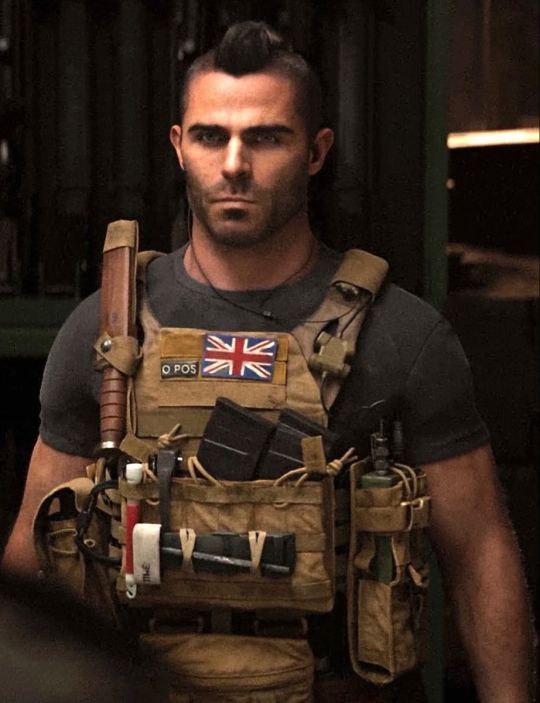
- He drew you like Gollum.
- I know, it sounds horrible, let me explain.
- You needed money, and you offered your services as a model for art classes.
- Soap was one of the students.
- During his leaves, he often took art classes to relax.
- And usually it goes well.
- But when he saw you....he thought he could never do justice to your face.
- He felt so self-conscious about his skills that he ended up doing a horrible portrait of you.
- And it could have ended up here, but the teacher decided to show everyone's pieces of art to analyze them
- So you saw Soap's piece where you looked like Gollum.
- And you knew it was from him.
- Everyone has a smile, while he was terrified.
- Usually, he's self-confident, but it's on the battlefield, in his life. The art was the only place where he was not sure he belonged too.
- At the end of the classes, he decided to talk to you.
- "I'm sorry for what happened today, I felt anxious and I ended up doing a bad portrait. It doesn't look like you at all."
- You looked up at him and smiled.
- "Why do you apologize? It was fun to see me like this, plus you need to start somewhere, no? You can't be a fucking Leonardo Da Vinci from the first day."
- He was too stunned to speak.
- "John or Johnny," he said.
- You looked at him confused.
- "Name's John, sorry, it seems you really blew my mind."
- You chuckled. "Nice to meet you, John. Hope next time your mind will be more confused for the next class."
- He nodded.
- Wait, did you say the next class? But it was nude models…
- Hope he won't draw a stick figure this time.
R U D Y
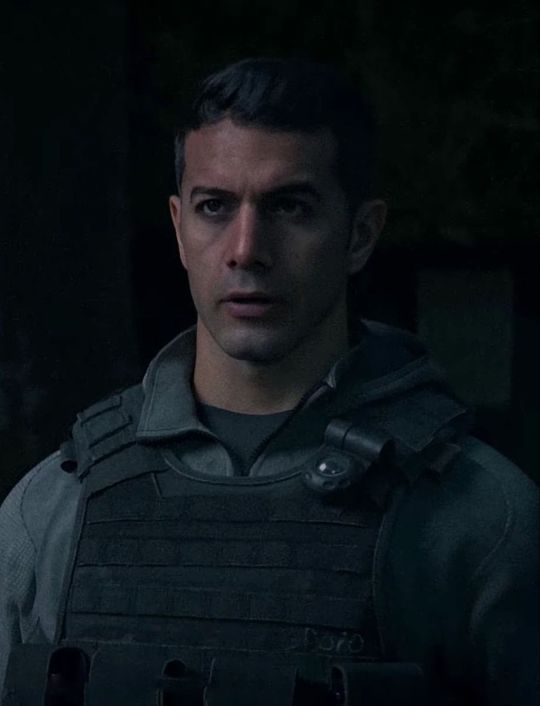
- You were an author.
- Well, it was not your main job since you only sold four books this year, but you considered yourself an author.
- And you had a hater. Someone who left a hateful review on each of your books.
- You knew that the next day after publishing your book, he would leave a bad review.
- So when your boss at the library told you that someone was regularly buying your books, you knew it could only be this hater, since the other person who bought your books was your mom.
- And you had had a bad day. So when your boss told you he was there, you were about to confront this hater.
- Maybe to understand what he didn't like or to know if he was just a coward.
- So you strode towards the spot your boss pointed at.
- "Hey, you," you said, not sure what to add after. When the man raised his head, he looked fit, and you knew you couldn't stand a chance in a fight if he decided to fight.
- "Wait, are you the author Y/N?" Rudy asked, with a sparkle in his eyes.
- Wait... A sparkle?
- "Hm, yeah, it's me," you answered, not sure what was happening.
- "I love your work. Your last book was really amazing. I have followed you since your debut."
- Your mouth was open, because :
1. one, your mom had lied to you when she told you she had bought three copies of your book.
2. And second, you had your first fan in front of you.
- "Thanks," you almost said, tears of joy welling up. "Sorry if I sound harsh. I thought you were that hater."
- "Oh yeah, I saw those reviews on your page. He's always there, but don't worry, I'll leave positive reviews to balance it. I'm Rudy, by the way."
- "Nice to meet you, and thanks for loving my work."
- "No need to thank me. I just appreciate good books."
- "What's your favorite, if I may ask?"
- Rudy smiled, and you both started chatting about books that afternoon. Maybe your reviews would improve after this, not just because of your writing, but also because he found you stunning.
G H O S T :
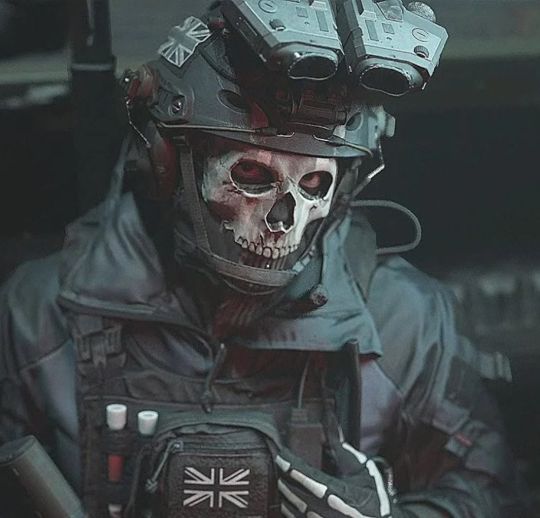
- Ghost scared people on the battlefield.
- However, the people who were most scared of him were the mechanics on the base.
- Ghost was a horrible driver, and everyone knew that.
- So, each time he went to the mechanics, they knew it was because he had done horrible damage to the cars.
- A game was organized whenever Ghost approached – you played rock, paper, scissors, and the loser had to fix his car.
- However, you were new to the base.
- When you saw this guy standing and waiting, you went to him without realizing all this.
- But when you saw his car, you understood why no one else was coming.
- He had a bowling ball in the trunk, the roof was broken, all the windows were shattered, and one tire was burnt.
- "...did you take this on the battlefield?" you asked.
- "No." He said shortly.
- You blinked. "Then why is it in this condition?"
- "There was a grandma on the road."
- "...so, because of a grandma, you have a bowling ball in your trunk?"
- "Because I swerved to avoid her and ended up hitting a bowling alley."
- "How did you even get a driver's license?"
- "The examiner was too sick to see me again for the ninth time, so he just gave it to me."
- "I guess I'll fix your car, but please don't drive if you don't need to, sir."
- "Sure."
- The next day, he was there again with a hole in the car because of a bird. How ? You didn't know.
-But it seemed you had become his official mechanic without even knowing it.
G A Z :
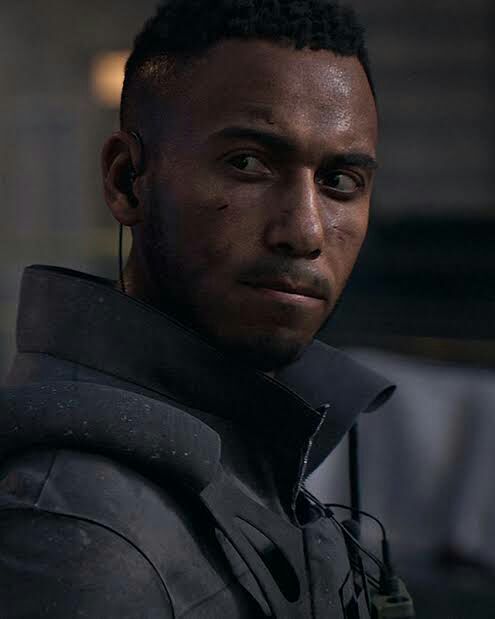
- When he hears your voice in a café, he recognizes you.
- The problem is, he can't come to you.
- Because if he knows your voice, it's because of your streams.
- Your ASMR streams.
- Being a soldier means your sleep schedule isn't really regular, and to help himself sleep, Gaz discovered ASMR.
- He found out about your streams, then your Patreon, and... let's just say your ASMR is spicy.
- So yes, if he says he's a fan of yours, it implies he has to reveal he listens to that in front of his teammates.
- And he's not ashamed of it.
- But he doesn't want Price to know he likes spicy ASMR, just like he wouldn't want to know what Price's fantasies are, or what Ghost likes in bed.
- (He wants to forget Soap's idea about Ghost in pink lingerie and a thong, and the day Price wore latex pants.)
- It's a line he doesn't want to cross.
- But he's also your biggest fan.
- So he tries to walk near you.
- But you're with a friend.
- And he doesn't know if your friend knows about this.
- So he ends up just glancing at you.
- Shit, how does he approach someone who does +18 things, without saying he knows they do this?
- Maybe if he waves... or just says hello? Or maybe if he asks for a selfie or…
- "Are you trying to imitate Ghost?" Soap asks.
- "What? No. Why do you say that?!" Gaz says, looking away.
- "Because you're staring at this person like they killed your dad and ate your mom, then burned your house and kidnapped your dog."
- "...it was really detailed for a scenario," Gaz says, confused.
- "So?"
- "I just know them, but I don't want to disturb them." Gaz says, trying to lie and tell the truth at the same time.
- If Soap finds out the truth, he'll never hear the end of it.
- "Do you want me to call them?"
- "NO. Absolutely not, don't do this, mate."
- "Why not?"
- Because they'll think you listen to their spicy ASMR audios, he wants to say, but he remains quiet.
- God, he feels like a teenager.
- But suddenly, he sees you walking towards them.
- You sit next to them, and... you wink at him, pointing to his key ring on his bag.
- It's your merch.
- Meaning... you know he's a fan.
- "Thanks for supporting me," you whisper before returning to your friend.
- Gaz doesn't speak until he gets back to base, too embarrassed but also too happy.
K E E G A N :
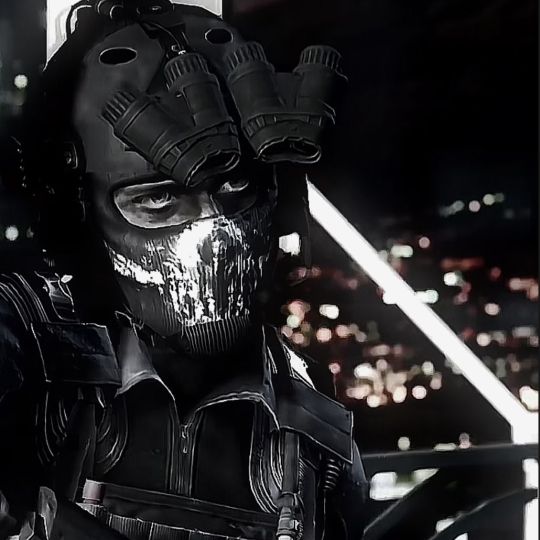
- You were tired.
- The rush had finally ended. It was now 11 PM, and there was this one client who had just ordered 10 Happy Meals.
- You wanted to slap him. He had ordered at 22:57, and the fast food closed at 23:00.
- So you didn't have a choice but to serve him.
- You looked at your colleague, who was sighing, and you nodded.
- You were preparing the trays, ready to see 10 kids running around and getting everything dirty, but…
- It was only one man with a mask.
- When you saw him, you were ready to raise your hands and give him money. Why the heck would a man with a gun and a mask be at a McDonald's at 23:00 buying 10 Happy Meals?
- But he just took them and ate.
- One after another.
- In silence.
- In five minutes.
- And then he left.
- You looked at your colleague.
- "Guess it's as weird as people who order a burger without buns," your colleague said.
- You nodded and thought it was just the one weird client of the day.
- But every Wednesday, he was there, in silence.
- Maybe he hated Ronald McDonald, so he planned to run out of your stock of Happy Meals?
- Or maybe he collected the toys?
- You didn't know, but he was there.
- And you saw him eating those nuggets and fries without sauce.
- He didn't touch his drinks. My, how dry it must be.
- But one Wednesday you took a day off. So when you came back the next day, you joked with your colleague about the Happy Meal guy.
- But they didn't laugh.
- "Who?" they asked.
- And just like that, you realized that when you weren't there, the Happy Meal guy wasn't there either.
- You were scared.
- Maybe he thought buying Happy Meals seduced you, or it was his way of warning you before he would kill you, like a threat, "You'll end up like those nuggets."
- So, when you saw him enter, you sent your colleague.
- However, your manager decided to give you your break at that moment, meaning it would be only you and him in the place.
- You tried to act normally, but you noticed how he seemed not to like his food yet still ate it.
- You sighed and sat next to him, offering him some sauces.
- "It's better with these. You know, you can have them for free in the menu next time."
- He looked at you and nodded.
- He then tried it and smiled.
- That's when you noticed his dog tags.
- "We have a discount for military personnel, so you could take a real meal instead of a Happy Meal if you want to."
- He looked surprised and nodded.
- Next time, he ordered 2 Happy Meals and two regular menus.
- So you smiled.
- Until his other masked colleagues ordered 20 Happy Meals because they liked the skull toys in them.
- Maybe it was just military men who had a problem with Happy Meals.
If you want more : my COD masterlist
And my masterlist
#cod x reader#call of duty x reader#price x reader#john price x reader#captain john price x reader#ghost x reader#simon ghost riley x reader#x reader#gaz x reader#kyle gaz garrick x reader#rudy parra x reader#rudy x reader#soap x reader#captain price x reader
2K notes
·
View notes
Text
In the Eye of the Beholder
So like I’m a bit late because the day is almost over but this is my entry for Garreth Weasley Fest 2024 ! My prompt was “Life drawing model (Garreth poses for a semi nude painting)”. This has been so fun and it was such a pleasure to participate.
Big big shout out to the wonderful @ellivenollivander and @cuffmeinblack for organizing all of this. You can find so much more Garreth content on @garrethweasleyfest !!!
18+ || MDNI || Content Warnings: explicit smut, aged up characters (this takes place a couple years post Hogwarts), lil bit of a size kink, dirty talk, unprotected p in v sex, Garreth’s pull out game is pretty strong, please let me know if I missed anything else
Word Count: 1.3k
Garreth Weasley x f!Non-MC!OC

Garreth had never been an insecure man. He liked his messy hair and his freckles. He thought he had nice eyes and a handsome smile. He liked the shape he was in, most of the time. He was relatively fit, his time spent farming had paid off and kept him in shape after finishing his schooling. It showed most when he went out, as he never seemed to struggle to find a witch to warm his bed.
There had been a sheet posted in the Three Broomsticks looking for volunteers to be models for some artist out in Brocburrow. His confidence in himself and a few too many drinks with Leander and Lucan, celebrating the latter’s graduation from Hogwarts, led to him signing his name and leaving his address for an owl on the sign up sheet. He watched as his already messy handwriting - made worse by the liquor flowing through his veins - disappeared on the parchment thanks to a variation of the protean charm. Not that he was sober enough to name it at this point. He returned to the table to the sound of hoots and jeers from his two fellow Gryffindors. By the time they left that night, he had forgotten all about it.
Within a week, there was an unfamiliar owl tapping at his window around lunch. He took the parchment from its outstretched leg, giving the bird a treat before it took off. His eyebrows furrowed in confusion as he tried to figure out who had written him before unrolling the parchment.
“Good morning Mr. Weasley,
I hope this letter finds you well. I’m writing in regards to the live model posting made in the Three Broomsticks. You provided your name and address as someone who may be interested in posing. The session will take place in Brocburrow next weekend. If you have no time conflicts and are still interested in having your portrait painted, I’ll meet you by the floo point in Brocburrow at noon. Please try to be punctual. If you have any further questions before next weekend, please feel free to write. You can send your owl to…”
The young woman, based on the signature at the bottom, provided her address and her name. He debated until the weekend whether he’d actually go or not. As the sun rose on Saturday morning and he realized he had less to do than he thought and it was only eight o’clock. He had plenty of time to finish his usual chores and get cleaned up before noon. He hurried through what he could, though he did curse at the chickens when they took their sweet time evacuating the coop. He was covered in sweat and dirt by the time he returned to his cottage.
By the time he popped through the floo at ten minutes before noon, he looked like a completely different man. He looked around before his eyes met those of a witch who was sitting in front of the floo.
“Mr. Weasley?”
She stood before he answered, her hand extending to shake his as she introduced herself.
“Minerva. You’re welcome to call me Minnie if you’d like.”
“You can just call me Garreth. Mr. Weasley is my dad,” he smiled as he shook her hand and his eyes raked over her much smaller figure.
The pair chatted idly as Minerva led the way to her portrait studio, admiring the leaves as they were changing due to the upcoming colder weather. As they entered the room, it was obvious where Garreth was meant to sit. He looked to the artist for guidance, since he knew he was simply there to be her muse, so to speak.
The young woman’s cheeks tinted slightly. “So, you’ll be posed in the middle there. You’ll have to remain relatively still, but it would be quite uncomfortable if we were just sitting here silently. So until I need your face, we’ll chat and I’ll try and make the face last and fast.”
Garreth chuckled and nodded at her explanation. “Pose me however you want, I’m just here to help you channel your artistic expertise.”
~~~~
When he said “however you want”, this hadn’t been what Garreth was expecting. Most of his clothes were folded on a chair and there was a black sheet draped over his lap. Minerva had very carefully adorned his red curls with a golden leafed headband that made him feel like a Greek god. Her hands had been all over his arms and his back as she posed him in a way that he assumed made the muscles in those parts the main focus. She had very gently turned his head to the side, and he allowed himself to scan over her face. He could already tell her pupils were dilated, and he heard her breath hitch when their eyes locked and green met the warmest brown he had ever seen.
He wasn’t sure who leaned in first, but he blinked and suddenly he was kissing the softest lips he had ever felt. He felt fingers tangle in his hair and pull, causing a moan to bubble up from his chest.
Garreth shifted, getting the witch settled beneath him. He worked eagerly to get her bared beneath him, pulling back to admire every inch of skin he could get his eyes and lips on.
“Bloody gorgeous…” he groaned as his head dipped down and he took a pert nipple between his lips. His tongue laved over the hardened bud to the tune of the prettiest whines to grace his ears. He pulled off one with a pop before giving her other breast the same attention.
“Garreth please,” she breathed, looking down at him through hooded eyes.
It was all the encouragement he needed to reach down and coat his fingers in her arousal before bringing them to her clit. He rubbed tight circles over the bundle of nerves, unable to fight the smirk on his face.
“Do all your muses get you this wet, little Minnie?”
Her answer never came, a moan tumbling from her lips as he pushed two fingers into her. He crooned, the tone turning condescending as he spoke.
“Merlin’s beard. Squeezing my fingers so tight. Dunno how you’re gonna take my cock.”
His thumb moved to rub her clit while his fingers continued to pump into her aching heat. He took cues from her to figure out the best angle, best pace, best rhythm. Garreth Weasley was nothing if not attentive to his partners.
“That’s it Minnie. Come on. I can feel it. Cum for me baby.”
With a loud cry of his name, he felt her walls fluttering around his fingers as her back arched off the stage. He wasted no time ridding himself of what little clothing remained on his body and very slowly worked every throbbing inch into the pretty artist beneath him. He watched her face, relishing in the way her eyes widened as she felt the stretch.
“I know. You’re doing so good for me. Such a good girl.”
“‘S so…” she trailed off into a whine, her eyes rolling back as he bottomed out.
“I know. And you’re taking all of it so well.”
With her confirmation, he started to rock his hips. He started slower but gradually he got faster, and based on the way Minerva was dragging her nails down his back he had found a good speed.
His hand moved between them, once again searching to increase her pleasure. As Garreth pushed them both, he could once again feel her impending release growing closer. It didn’t take much to work them both over the edge, and Garreth painted her stomach white.
He fell beside her, his heart racing and his chest heaving as he tried to catch his breath.
“So,” she asked breathlessly, still trying to get her bearings, “are you free to pose next week?”
#Garreth Weasley Fest#garreth weasley fanfiction#garreth weasley smut#garrethweasleyfest#Garreth Weasley#hogwarts legacy#hogwarts legacy fic#hogwarts legacy fanfic
32 notes
·
View notes
Text

Philip Hermogenes Calderon, RA The Orphans 1870. Oil on canvas
Philip Hermogenes Calderon RA (Poitiers 3 May 1833 – 30 April 1898 London) was a British painter of French birth (mother) and Spanish (father) ancestry, who initially worked in the Pre-Raphaelite style before moving towards historical genre painting. He was Keeper of the Royal Academy in London.
Calderon was born in Poitiers, France. His father, the Reverend Juan Calderón (* 19 April 1791 in Villafranca de los Caballeros; † 28 January 1854 in London) was a professor of Spanish literature and a former Roman Catholic priest who had converted to Anglicanism. Calderon planned to study engineering, but he became so interested in drawing technical figures and diagrams that he changed his mind and devoted his time to art. In 1850, he trained at Leigh's art school, London, then went to Paris to study under François-Édouard Picot in 1851. His first successful painting was called By the waters of Babylon (1852), which was followed by a much more popular one called Broken Vows (1856). From the beginning he was inspired by the Pre-Raphaelites, and some of his work showed the detail, deep colors, and realistic forms that characterize the style. The artist Henry Stacy Marks was his friend and brother-in-law, and Calderon exhibited his portrait at the Royal Academy in 1872.
Calderon became a leading member of the St John's Wood Clique, a group of artists interested in modern genre and historical subjects who were inspired, both artistically and socially by the Pre-Raphaelites. Historical, biblical, and literary themes were common in Calderon's later work. Many of his pieces show women wearing rich, silky clothing in gently colored landscapes. His Morning (1884) features a copper-haired maiden watching a sunrise.
His Juliet (1888) shows Shakespeare's Juliet seated on her balcony gazing at the stars. His later paintings adopt a more classical style, comparable to Edward Poynter, which resulted from his close relationship with Frederic Leighton, then-President of the Royal Academy. Calderon became Keeper of the Royal Academy in 1887, and from then on worked to support the teaching of anatomy based on nude models at the Royal Academy Schools. His 1891 painting St Elizabeth of Hungary's great act of renunciation was secured by the Chantrey bequest for the national collection, and is now located in Tate Britain, but caused considerable controversy because of its perceived anti-Catholic message. It depicted the saint bending nude over an altar watched by monks.
4 notes
·
View notes
Text
Bisexual!Michael Masterlist
but then i hear u calling (there u are) (ao3) - orphan_account michael/luke N/R, 933
Summary: michael and luke have always been the closest. friendly kisses lasting no longer than 3 seconds are shared frequently between the duo- calum and ashton watching from a distance, almost admiring their friendship. until it wasn't a friendship anymore.
How You Get the Girl (ao3) - 1loulu5 michael/calum, michael/ofc T, 2k
Summary: “Wh… What does ‘castrate’ mean?” Michael sounded perplexed.
Calum laughed, “It means I’ll cut your balls off.”
“Oh-”
~~~
Michael calls Calum, his ex for the past 4 years, for relationship advice.
Not Just a Stupid Game (ao3) - coffeemuke michael/luke E, 2k
Summary: A game of truth or dare leads to Michael following through on a dare.
Paint Me - @daydadahlias (cornflowerblue (daydadahlias)) luke/ashton, michael/crystal E, 17k
Summary: “Holy shit, hold on a minute,” Calum says, “is that who we’re supposed to be drawing?”
“I can’t draw him,” Michael gawks, “I’m not a Goddamn renaissance painter.”
Or, the one where Luke is an art student practicing realism for a month and Ashton is the nude model in his portrait class.
Promise (ao3) - boomercal calum/ashton, sierra/luke, michael/crystal, calum/ofc M, 115k
Summary: Live music photographer Calum does one favour for a friend (filling in last minute for a show), and his life changes for good. Finding his muse, world-famous pop/rock sensation Ashton Irwin. He thinks once the shows are over, he can pack it in and forget all about it, but a Google search and a phone call set him up on a North American tour where he'll see the man every day... Too bad his Google search revealed the man of his every fantasy has a purity pact with God. So what's a..promiscuous young man to do? Repress it? Sure, that'll work.
Tangled in a Triangle (ao3) - orsumeuphoria michael/crystal/ashton E, 9k
Summary: “You ever have him like this, Crys?” Ashton asks. Crystal doesn’t say anything, but she must shake her head because Ashton continues, “Shame. I think you’d like it. He’s so pretty on his knees.” Michael keens. “C’mere.”
Crystal’s immaculate sneakers appear right behind Ashton’s boots.
The next command he gets isn’t spoken. Ashton only has to tap the base of his jaw for Michael to look up.
The image of both Ashton and Crystal towering over him, Ashton smiling softly and Crystal looking intrigued, is one he burns into his memory.
“Hi, dove,” Ashton murmurs softly, “Fucking missed you.”
The Blower's Daughter (ao3) - MyMy michael/calum, luke/ashton M, 13k (WIP)
Summary: “Did you need something else?” Michael inquires politely a little confused himself.
“I was wondering if I could get your number actually?” The stranger asks biting his lip into his mouth quickly.
“Oh sure!” Michael replies happily. He reaches around the register to the side facing the customer and feels around for the little stack of cards with the shop info on it and the logo embossed in solid black.
“Here this has the shop number right here.” Michael points to the tiny row of numbers on the card. “So if you need anything don’t be afraid to call, okay? We can do special orders as well so anything music related we’ll try our best to get it for you!”
The Gayest Thing I've Ever Done (ao3) - coffeemuke michael/luke, calum/ashton E, 1k
Summary: Band bonding crosses the line between normal and weird, and it's Luke's fault. But the boys don't seem to mind.
The Posse's Origin (ao3) - Jay_isnotokay calum/ashton, michael/ashton E, 6k
Summary: "...I've been apart of the princess posse for a few weeks now and I still don't how you two got 'initated' in the first place." Luke said.
"Alright, LuLu, have I got a story for you."
~
Or Luke wants to know how the posse started and, well, they tell him.
up to your mouth, feeling it out (ao3) - orphan_account michael/luke, luke/ashton E, 9k
Summary: Ashton's the one who suggested it; after all, he would know how well Luke would do in the industry, since he spent most Friday nights with his best friend's lips around his cock. Luke, on the other hand, didn't know he would end up fluffing for a record-breaking pornstar who is like, really really hot, and definitely his type.
or, Luke is broke and has a talented mouth (and a tongue piercing).
your string of lights is still bright to me (ao3) - merlypops michael/calum E, 81k
Summary: Michael is struggling to be the father his daughters need. Until he meets Calum again.
#5sosfanfictioncatalogue#5sos fanfic#masterlists#bisexual#bisexual!michael#bisexual!michael masterlist
2 notes
·
View notes
Text

Impressionism women in history 𓅔
Welcome to my history literature-art-class. Please take a seat.



Berthe Morisot (1841–95)
Berthe Morisot is the best-known of the female Impressionists, having been given a solo retrospective that traveled Europe and North America starting in 2018. Born in 1841, Morisot first showed at the age of 25 at the 1864 Paris Salon. Morisot was the only woman invited to show in the first Impressionist exhibition (formerly called the Anonymous Society of Painters, Sculptors and Printmakers) in 1874, and she went on to participate in all but one of the eight exhibitions between from 1874 to 1886. She was close with Manet, even marrying his brother, and the two influenced each other, in a way that ultimately moved her work in bolder, more abstract directions. She painted with loose, bold brushstrokes that emphasized expressivity over naturalism. A critic wrote at the time, “Her painting has all the frankness of improvisation; it truly is the impression caught by a sincere eye and accurately rendered by a hand that does not cheat.” In the The Garden at Maurecourt (ca. 1884), she depicts a mother gazing at her child with little sentimentally, perhaps even boredom or exhaustion. With its probing depiction of its sitter’s mental state, the painting exemplifies Morisot’s sensibility. Morisot died of pneumonia in 1895, at the age of 54, leaving behind an oeuvre that hints at the further breakthroughs she was poised to make.
(BTW, here you can get wallpapers from her)



Mary Cassatt (1844–1926)
Mary Cassatt was the only American among the founding Impressionists. She came from a well-off family in Pittsburgh that supported a formal arts education first at the Pennsylvania Academy of the Fine Arts and then in Europe, after the vaunted Philadelphia school rebuffed her requests to study nude models. During her travels throughout the continent she learned under academic mentors such as Jean-Léon Gérôme and Édouard Frère and studied classical masterpieces by Correggio, Velázquez, Rubens. She settled in Paris in 1874, where she began regularly showing her portraits in the Salon. In 1877 Degas invited her to begin showing with the Impressionists, and she participated in four of the eight exhibitions. “No woman has the right to draw like that,” Degas reportedly said upon viewing Cassatt’s Young Women Picking Fruit (1891). She took the thinly veiled insult in stride, and the two maintained a close friendship based on a shared respect for asymmetrical composition and classical Japanese prints. Cassatt supported herself as a successful portrait artist and printmaker, having declared herself unfit for marriage or motherhood. In spite of this, her subject was often. the relationship between mothers and their children. In contrast to Morisot’s bold, expressive brushwork, Cassatt often depicted her the facial features and figure of her friends and family with great precision. In The Boating Party, the man’s expression is obscured, placing the focus on a deftly rendered woman and child. Cassatt once said her goal was to depict women as “subjects, not objects.”



Eva Gonzalès (1849–83)
Gonzalès never exhibited with the Impressionists, but she was close with some of the movement’s top artists—including Morisot—and her art is stylistically similar to their work. Like other aspiring female artists in 19th-century France, Gonzalès was barred from attending the École des Beaux-Arts, though like Morisot and Cassatt, her affluent upbringing afforded her the opportunity to attend private lessons. In 1869, she met Manet in Paris, and she became his only formal student. His influence on her work is evident in A Box at the Theatre des Italien‘s flat perspective at the subject’s direct gaze. The year they met, Manet created a portrait of Gonzalès, and in response she produced her own series of self-portraits, asserting her identity as professional peer—something far more than a museu. She died in 1883 at age 34 from an embolism after the birth of her son, having achieved her goal of exhibiting in the prestigious Paris Salon. In 1885, a 90-piece retrospective of her work was held at the Salons de la Vie Moderne in Paris.
Could write a book about them, ngl.
Thank you for reading till the end,
Atenea 𓅖
#books#poetry#literature#monet#manet#impressionism#feminismo#feminist#woman#women#art#women in art#art movment
16 notes
·
View notes
Photo
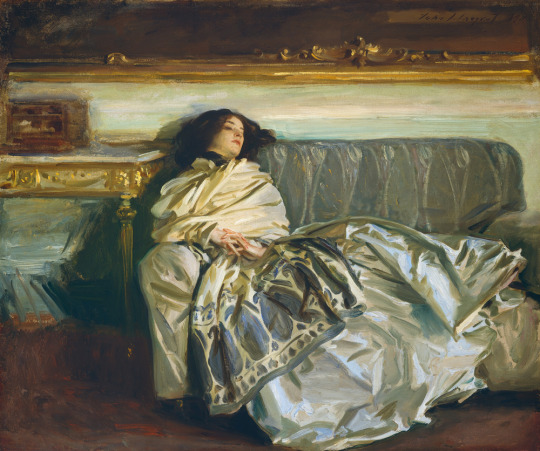
John Singer Sargent Nonchaloir (Repose) (1911) Oil on canvas, 63.8 x 76.2 cm National Gallery of Art, Washington
Highlights from around the web 💫
✨ John Singer Sargent was an American expatriate artist, considered the "leading portrait painter of his generation" for his evocations of Edwardian-era luxury. He created roughly 900 oil paintings and more than 2,000 watercolors, as well as countless sketches and charcoal drawings. His oeuvre documents worldwide travel, from Venice to the Tyrol, Corfu, the Middle East, Montana, Maine, and Florida. [1]
✨ Although based in Paris, Sargent's parents moved regularly with the seasons to the sea and the mountain resorts in France, Germany, Italy, and Switzerland. His mother was convinced that traveling around Europe, and visiting museums and churches, would give young Sargent a satisfactory education. Early on, she gave him sketchbooks and encouraged drawing excursions. Although his education was far from complete, Sargent grew up to be a highly literate and cosmopolitan young man, accomplished in art, music, and literature. He was also fluent in English, French, Italian, and German. [2]
✨ Sargent was a lifelong bachelor with a wide circle of friends including both men and women such as Oscar Wilde (whom he was neighbors with for several years), lesbian author Violet Paget, and his likely lover Albert de Belleroche, whom he met in 1882 and traveled with frequently. A surviving drawing speculatively may hint that Sargent might have used Belleroche as a model for Madame X, his most infamous work. Recent scholarship has speculated that Sargent was a homosexual man, based on statements by his friends and associations, the way his works challenge 19th-century notions of gender difference, and some nude male portraits, including that of Belleroche, which hung in his Chelsea dining room. One client wrote that when in Venice, Sargent "was only interested in the Venetian gondoliers" while another said that his sex life "was notorious in Paris, and in Venice, positively scandalous." [3]
✨ After securing a commission, Sargent would visit the client's home to see where the painting was to hang. He would often review a client's wardrobe to pick suitable attire. He usually required eight to ten sittings from his clients, although he would try to capture the face in one sitting. He usually kept up pleasant conversation and sometimes he would take a break and play the piano for his sitter. Finally, he would select an appropriate frame. In 1907, at the age of fifty-one, Sargent officially closed his studio. Relieved, he stated, "Painting a portrait would be quite amusing if one were not forced to talk while working…What a nuisance having to entertain the sitter and to look happy when one feels wretched." [4]
✨ Despite his success as one of the most sought–after portraitists of the late Victorian era, Sargent eventually became exasperated by the whim and vanities of prominent sitters. By 1909 he had abandoned conventional portraiture in order to "experiment with more imaginary fields." The woman in Repose is Sargent's niece, Rose-Marie Ormond. In keeping with his newfound preference for informal figure studies, Sargent did not create a traditional portrait; rather, he depicted Rose–Marie as a languid, anonymous figure absorbed in poetic reverie. The reclining woman, casually posed in an atmosphere of elegiac calm and consummate luxury, seems the epitome of nonchalance—the painting's original title. Sargent seems to have been documenting the end of an era, for the lingering aura of fin–de–siècle gentility and elegant indulgence conveyed in Repose would soon be shattered by massive political and social upheaval in the early 20th century. [5]
Thanks for reading this far. I hope you found this glimpse into Sargent’s life and artistic practice as interesting as I did! If you’re feeling inspired feel free to shop the merch links below. Pro tip: the t-shirt in XL makes a great night gown if you want to channel your inner Rose-Marie! 😴
↪ Get this design on a t-shirt, sweatshirt, or notebook 🥀
#john singer sargent#nonchaloir (repose)#american art#oil painting#art history#dark academia#dark academia aesthetic#light academia#light academia aesthetic#academia aesthetic#archive aesthetic#back to school#art major#curators on tumblr#sleep#portrait#impressionism#lgbt representation#oscar wilde#history facts
14 notes
·
View notes
Text
Nude Self-Portrait, Albrecht Dürer c.1500-5

Dürer's self-examination and his studies of the human body combined in the Nude Self-Portrait (c. 1500-5). This is another absolutely novel image, since there are no surviving earlier full-length, nude self-studies by other artists. Dürer portrayed himself clad only in hairnet or cap. His stare suggests that he looks a small mirror propped on a nearby table at roughly the same position as the viewer. This makes the intensity of his gaze and the frank representation of his body rather disconcerting. The genitals are just as carefully described as the face. There is speculation, much unfounded, about the artist's health, intentions and audience. Dürer was sick in 1503, as is known from the inscription ('during my illness') on his The Head of the Dead Christ sketch. Panofsky remarks: 'The convalescent painter looks at his emaciated body and still haggard face with the same mixture of fatigue, apprehension and dispassionate curiosity with which a farmer might take stock of his crops after a bad storm.' Is this judgement based truly on what the Weimar drawing conveys or on two later drawings linked with future illnesses? Dürer portrayed his body, especially the torso, as robust. Is his face gaunt or just summarily described? The artist who made punning references to the cock spout in the Men's Bath may have been foregrounding his own manliness in this chiaroscuro drawing. Rather than looking to Christological or Freudian interpretations, the sketch must be considered with his contemporary studies of the real and ideal human body. While making life drawings of models, constructing Vitruvian-proportioned figures and exploring ancient prototypes, contemplating his own body must have seemed like a logical exercise. The black backdrop and aspects of the pose recall his roughly contemporary drawing of Adam.
- Jeffrey Chipps-Smith, Dürer, Phaidon
me i think the green background is particularly sickly
6 notes
·
View notes
Photo
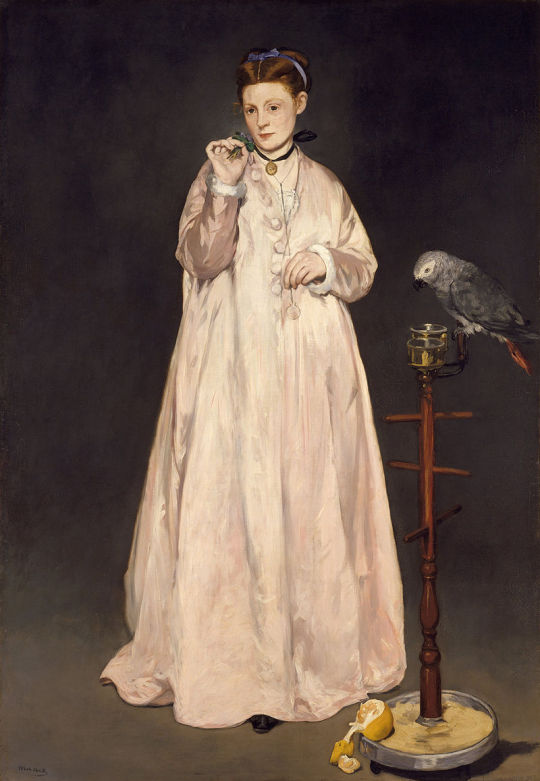
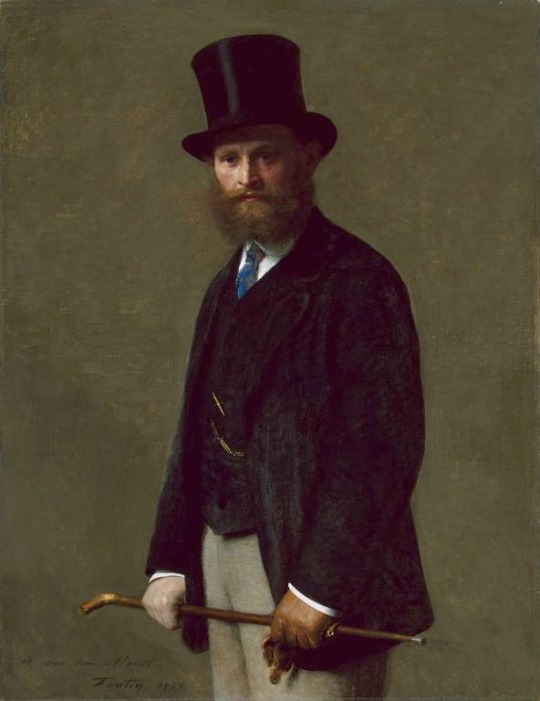

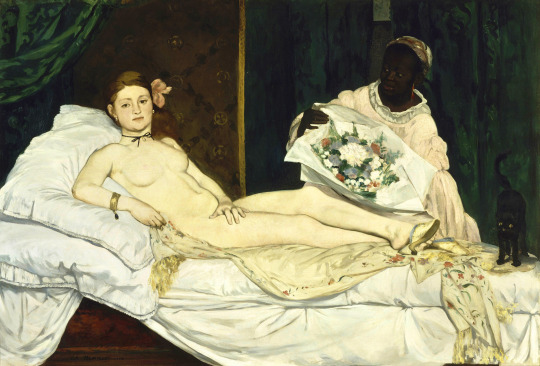
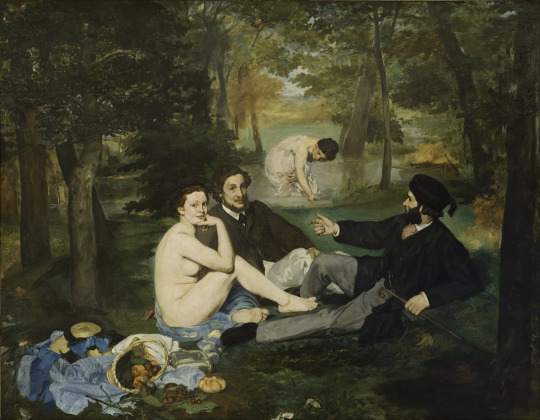
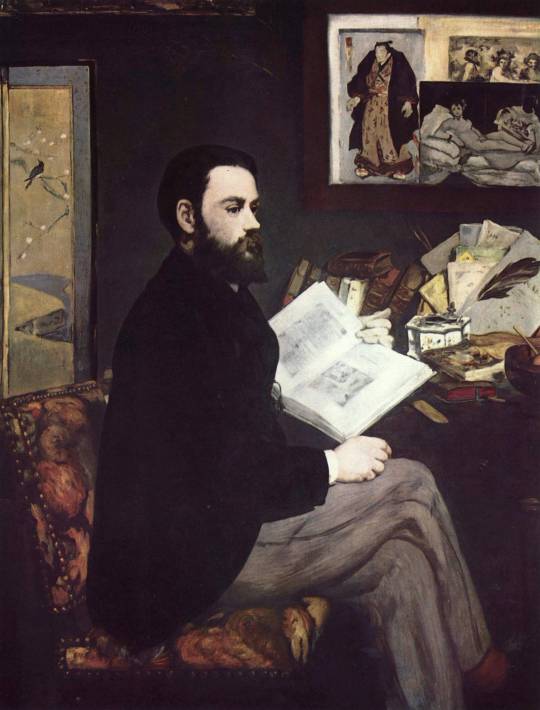

Édouard Manet French: 23 January 1832 – 30 April 1883) was a French modernist painter. He was one of the first 19th-century artists to paint modern life, and a pivotal figure in the transition from Realism to Impressionism.
Born into an upper-class household with strong political connections, Manet rejected the future originally envisioned for him, and became engrossed in the world of painting. His early masterworks, The Luncheon on the Grass (Le déjeuner sur l'herbe) and Olympia, both 1863, caused great controversy and served as rallying points for the young painters who would create Impressionism. Today, these are considered watershed paintings that mark the start of modern art. The last 20 years of Manet's life saw him form bonds with other great artists of the time, and develop his own style that would be heralded as innovative and serve as a major influence for future painters.
Le Déjeuner sur l'herbe ( Luncheon on the Grass )
A major early work is The Luncheon on the Grass (Le Déjeuner sur l'herbe), originally Le Bain. The Paris Salon rejected it for exhibition in 1863, but Manet agreed to exhibit it at the Salon des Refusés (Salon of the Rejected) which was a parallel exhibition to the official Salon, as an alternative exhibition in the Palais des Champs-Elysée. The Salon des Refusés was initiated by Emperor Napoleon III as a solution to a problematic situation which came about as the Selection Committee of the Salon that year rejected 2,783 paintings of the ca. 5000. Each painter could decide whether to take the opportunity to exhibit at the Salon des Refusés, less than 500 of the rejected painters chose to do so.
Manet employed model Victorine Meurent, his wife Suzanne, future brother-in-law Ferdinand Leenhoff, and one of his brothers to pose. Meurent also posed for several more of Manet's important paintings including Olympia; and by the mid-1870s she became an accomplished painter in her own right.
The painting's juxtaposition of fully dressed men and a nude woman was controversial, as was its abbreviated, sketch-like handling, an innovation that distinguished Manet from Courbet. At the same time, Manet's composition reveals his study of the old masters, as the disposition of the main figures is derived from Marcantonio Raimondi's engraving of the Judgement of Paris (c. 1515) based on a drawing by Raphael.
Two additional works cited by scholars as important precedents for Le déjeuner sur l'herbe are Pastoral Concert (c. 1510, The Louvre) and The Tempest (Gallerie dell'Accademia, Venice), both of which are attributed variously to Italian Renaissance masters Giorgione or Titian. The Tempest is an enigmatic painting featuring a fully dressed man and a nude woman in a rural setting. The man is standing to the left and gazing to the side, apparently at the woman, who is seated and breastfeeding a baby; the relationship between the two figures is unclear. In Pastoral Concert, two clothed men and a nude woman are seated on the grass, engaged in music making, while a second nude woman stands beside them.
Olympia
As he had in Luncheon on the Grass, Manet again paraphrased a respected work by a Renaissance artist in the painting Olympia (1863), a nude portrayed in a style reminiscent of early studio photographs, but whose pose was based on Titian's Venus of Urbino (1538). The painting is also reminiscent of Francisco Goya's painting The Nude Maja (1800).
Manet embarked on the canvas after being challenged to give the Salon a nude painting to display. His uniquely frank depiction of a self-assured prostitute was accepted by the Paris Salon in 1865, where it created a scandal. According to Antonin Proust, "only the precautions taken by the administration prevented the painting being punctured and torn" by offended viewers.[9] The painting was controversial partly because the nude is wearing some small items of clothing such as an orchid in her hair, a bracelet, a ribbon around her neck, and mule slippers, all of which accentuated her nakedness, sexuality, and comfortable courtesan lifestyle. The orchid, upswept hair, black cat, and bouquet of flowers were all recognized symbols of sexuality at the time. This modern Venus' body is thin, counter to prevailing standards; the painting's lack of idealism rankled viewers. The painting's flatness, inspired by Japanese wood block art, serves to make the nude more human and less voluptuous. A fully dressed black servant is featured, exploiting the then-current theory that black people were hyper-sexed.[4] That she is wearing the clothing of a servant to a courtesan here furthers the sexual tension of the piece.
Olympia's body as well as her gaze is unabashedly confrontational. She defiantly looks out as her servant offers flowers from one of her male suitors. Although her hand rests on her leg, hiding her pubic area, the reference to traditional female virtue is ironic; a notion of modesty is notoriously absent in this work. A contemporary critic denounced Olympia's "shamelessly flexed" left hand, which seemed to him a mockery of the relaxed, shielding hand of Titian's Venus.[10] Likewise, the alert black cat at the foot of the bed strikes a sexually rebellious note in contrast to that of the sleeping dog in Titian's portrayal of the goddess in his Venus of Urbino.
Olympia was the subject of caricatures in the popular press, but was championed by the French avant-garde community, and the painting's significance was appreciated by artists such as Gustave Courbet, Paul Cézanne, Claude Monet, and later Paul Gauguin.
As with Luncheon on the Grass, the painting raised the issue of prostitution within contemporary France and the roles of women within society.
A Bar at the Folies-Bergère (Un Bar aux Folies-Bergère), 1882, Courtauld Gallery, London
In his last years Manet painted many small-scale still lifes of fruits and vegetables, such as Bunch of Asparagus and The Lemon (both 1880). He completed his last major work, A Bar at the Folies-Bergère (Un Bar aux Folies-Bergère), in 1882, and it hung in the Salon that year. Afterwards, he limited himself to small formats. His last paintings were of flowers in glass vases.
Manet's public career lasted from 1861, the year of his first participation in the Salon, until his death in 1883. His known extant works, as catalogued in 1975 by Denis Rouart and Daniel Wildenstein, comprise 430 oil paintings, 89 pastels, and more than 400 works on paper.
The grave of Manet at Passy
Although harshly condemned by critics who decried its lack of conventional finish, Manet's work had admirers from the beginning. One was Émile Zola, who wrote in 1867: "We are not accustomed to seeing such simple and direct translations of reality. Then, as I said, there is such a surprisingly elegant awkwardness ... it is a truly charming experience to contemplate this luminous and serious painting which interprets nature with a gentle brutality."
The roughly painted style and photographic lighting in Manet's paintings was seen as specifically modern, and as a challenge to the Renaissance works he copied or used as source material. He rejected the technique he had learned in the studio of Thomas Couture – in which a painting was constructed using successive layers of paint on a dark-toned ground – in favor of a direct, alla prima method using opaque paint on a light ground. Novel at the time, this method made possible the completion of a painting in a single sitting. It was adopted by the Impressionists, and became the prevalent method of painting in oils for generations that followed. Manet's work is considered "early modern", partially because of the opaque flatness of his surfaces, the frequent sketchlike passages, and the black outlining of figures, all of which draw attention to the surface of the picture plane and the material quality of paint.
The art historian Beatrice Farwell says Manet "has been universally regarded as the Father of Modernism. With Courbet he was among the first to take serious risks with the public whose favour he sought, the first to make alla prima painting the standard technique for oil painting and one of the first to take liberties with Renaissance perspective and to offer "pure painting" as a source of aesthetic pleasure. He was a pioneer, again with Courbet, in the rejection of humanistic and historical subject-matter, and shared with Degas the establishment of modern urban life as acceptable material for high art."
Art market
The late Manet painting, Le Printemps (1881), sold to the J. Paul Getty Museum for $65.1 million, setting a new auction record for Manet, exceeding its pre-sale estimate of $25–35 million at Christie's on 5 November 2014. The previous auction record was held by Self-Portrait With Palette which sold for $33.2 million at Sotheby's on 22 June 2010.[38]
https://en.wikipedia.org/wiki/%C3%89douard_Manet
8 notes
·
View notes
Text

PHIL HALE
Phil Hale was born in 1963 in Boston, Massachusetts and has been based in London since 1985. Born into a family of artists, Hale became an apprentice to American painter Rick Berry at the age of sixteen. Much of his early professional work was as an illustrator for clients such as Stephen King, RayGun, Playboy and Spectrum. His fine art works have been exhibited throughout the United States and Europe and held in the collections of the National Portrait Gallery, the Houses of Westminster, Lords Cricket Ground, Sony and Warner Bros. In 2008, Hale was commissioned to paint the portrait of Tony Blair, the former Prime Minister of the United Kingdom.
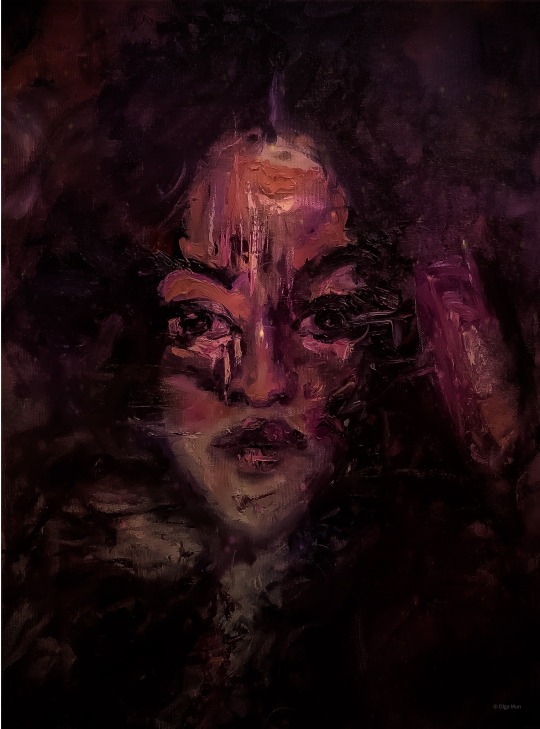
Strive to cope with the already vague anxiety in your body like an ocean wave, and you don't even feel like going back to work when you criticize constantly. There's no downtime for yourself. That means wow. I saw this show, and now I have to start to come to my senses and more often than not agree with myself on the merits. This is Good. This is bad. It's not. I wouldn't say there are compelling arguments, and again, when I tend to quit painting it, it groans witty. So you pass that to her argument after you've discussed it, don't do it justice. Anyway, to paint, you must to remain to know the degree, and you want to get an award! There are many people around and many scientists who did not want it to look like this. Yeah.


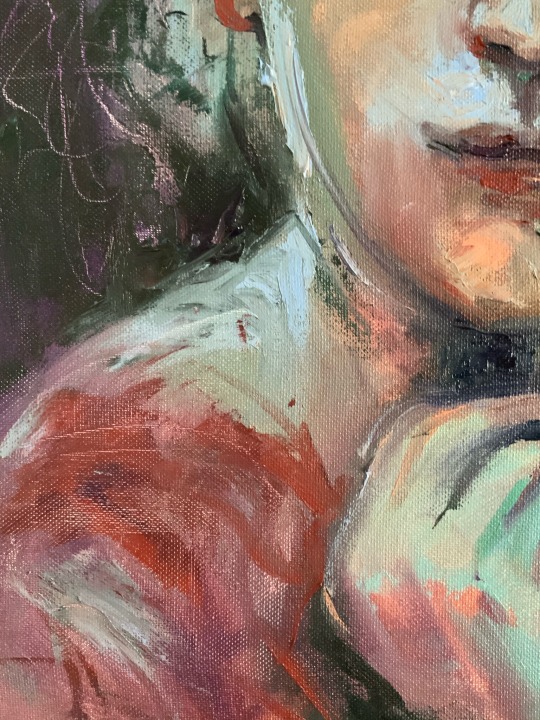
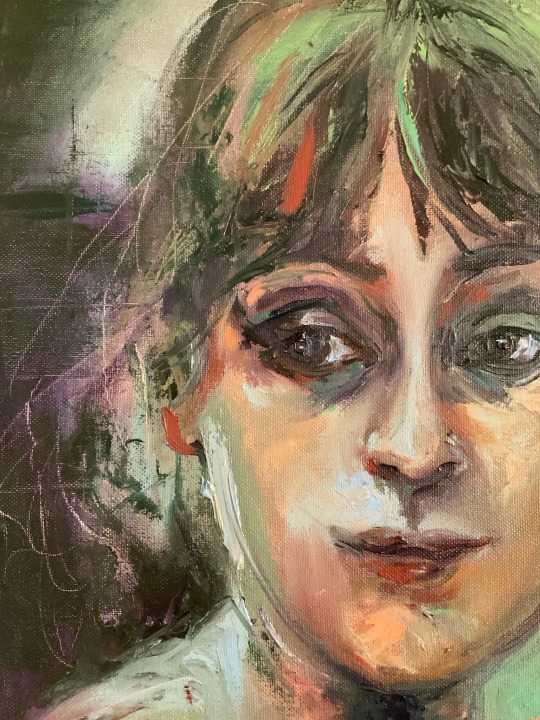
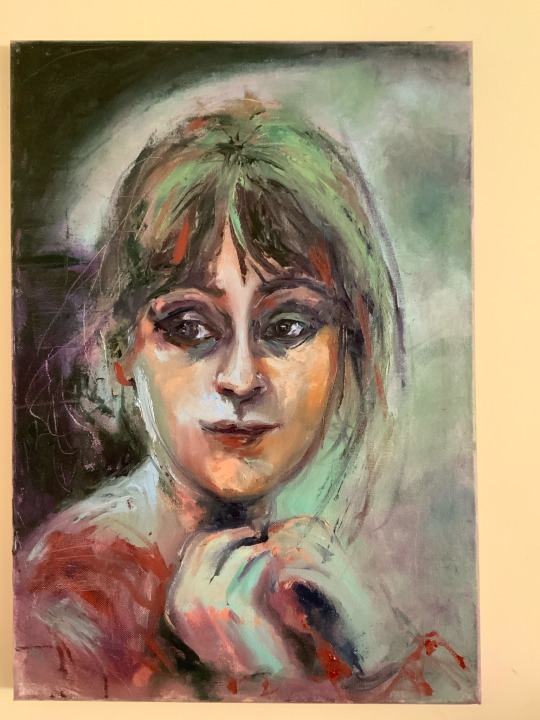
An endless stream of ideas that I keep pondering, but for some reason, it seems too difficult to tackle - I don't have the time, finances, or focus to bring it all together. Perhaps decisiveness, vision. To create this work, it took me a whole year, since I was carrying this image in my head for a long time, I took a shot last year at one of the lessons on the basics of photography, totally by accident, but I liked her expression that was not played in front of the camera, but a living and vital, moment thinking about something important. Although the oil painting looks unfinished and it is not, I like to keep it as it is, because it gives me thoughts about time as Air perspective is an image of an object, taking into account the apparent light changes in the space. It is straightforward to see in this example. However, it also requires your imagination. In other words, everything that we see farther from us is less bright, clear, smaller in size, less visible details. This is because the time as air also has density, colour (impurities are present: dust, fog, smoke, rain). We see the distant plan as if in a "haze" through a layer of air or as l am suggesting time. The distant shot is always faded.
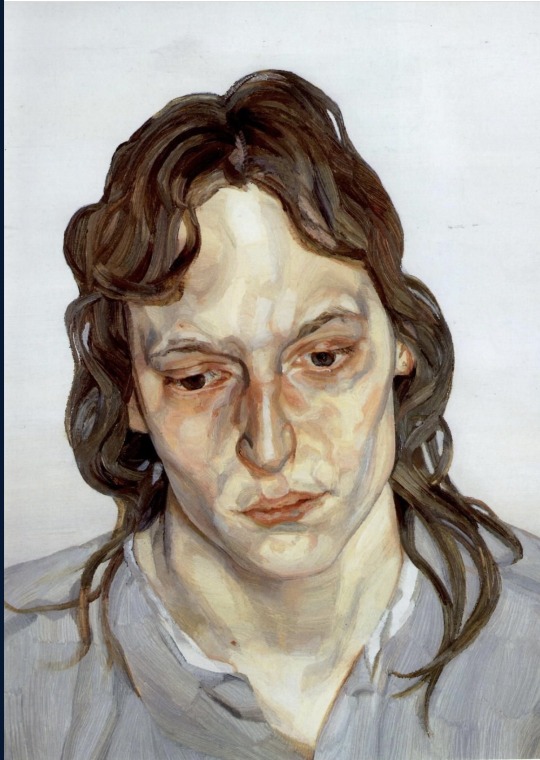

His work as a doctrine based on continuous development. It is important to break through to it through many obstacles of being, to comprehend the truth, for harmony and balance. I cannot look at the works of Lucien Freud, they set me on fire. A great master, stubborn and thoughtful in his gift of persuasion, who carefully studied in his work, castigated himself and his victims posing for him, now we are spectators, tormented by his questions, and the scripture is remembered; but the one who loves him from childhood punishes. “In his works, he appears as the father of humanity, punishing the body for the Path to Truth. It was only natural that the turn through creativity laid the foundation for deep knowledge. Painting as a doctrine based on continuous development. It is important to break through to him through many obstacles of being, to comprehend the truth, for harmony and balance
“Lucian Freud was born into an artistic middle-class Jewish family. His father Ernst was an architect, his mother Lucie Brasch studied art history, and his grandfather was the paradigm-shifting psychoanalyst Sigmund Freud. In 1933, Freud and his family left Berlin to escape Hitler and settled in London.”
was stubborn and believed in his gift of persuasion, a thoroughly studying Lucian in his work scourged himself and his victims posing for him now we are the viewer under the torture of his questions and the holy scripture is remembered; and he who loves, punishes him from childhood. "In his works, he appears as the father of mankind, punishing the body for the Path to Truth
“Lucian Freud, renowned for his unflinching observations of anatomy and psychology, made even the beautiful people (including Kate Moss) look ugly. One of the late twentieth-century's most celebrated portraitists, Freud painted only those closest to him: friends and family, wives and mistresses, and, last but not least, himself. His insightful series of self-portraits spanned over six decades. Unusual among artists with such long careers, his style remained remarkably consistent. Perhaps inevitably, the psychic intensity of his portraits, and his notoriously long sessions with sitters have been compared with the psychoanalytic practice of his famous grandfather, Sigmund Freud. Unapologetically self-absorbed, Freud embodied a notion that comes to us from the Renaissance, and which has been attributed to Leonardo da Vinci: "Every artist paints himself." Freud remained aloof from his sitters, a rapport that comes through in his work, referring to the work as "purely autobiographical" and the people he painted as merely the vehicle for figurative innovations: "I use the people to invent my pictures with, and I can work more freely when they are there."While life drawing classes had long included nude models, the expressive detail with which Freud paints genitals sets him apart from other artists in the history of portraiture. With the analytic scrutiny and detail a botanical illustrator might devote to a rare flower, Freud paints primary and secondary sex characteristics.Freud owes much to the early-20th-century Expressionists. His pronounced, expressive strokes recall Egon Schiele and Edvard Munch, and the tilted perspective and anthropomorphic depictions of chairs, shoes, and other inanimate objects bring to mind Vincent van Gogh.Freud was one of the great self-portraitists of the 20th century. He painted himself obsessively. While it may lack the range of Rembrandt, Van Gogh, or Schiele, Freud's self-portraits form one of the most complete visual autobiographies of any painter, yielding insight into the self-absorption and relentless drive that fueled the artist.”
“Biography of Lucien Freud (Lucian Michael Freud) is full of paradoxes. He was a rebel, breaking the rules at every opportunity, and managed to live to be 88 years. All his life he was reserved and secretive, but was wildly popular among the women and told them to reciprocate. His private life has become a byword, but he about it was never extended. Freud rarely gave interviews and were jealous of their personal space from the press and from strangers. His fame resounded around the world, but in the artist's life were not written any biographical book about him. https://artchive.ru/en/lucianfreud
3 notes
·
View notes
Photo
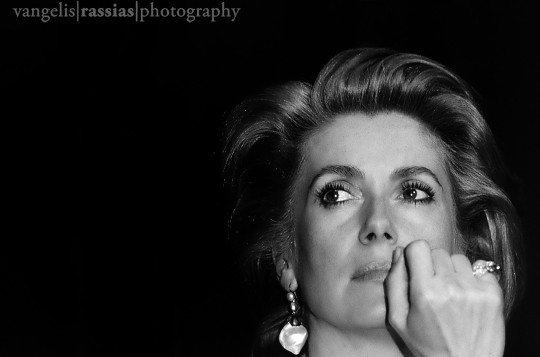
#Catherine Deneuve Portrait
Cannes 1984
Contax RTS Carl Zeiss T* Tessar 200mm f/3,5 Agfapan 100
Catherine Fabienne Dorléac (born 22 October 1943), known professionally as Catherine Deneuve , is a French actress as well as an occasional singer, model and producer, considered one of the best European actresses and the greatest French actress of all time.. She gained recognition for her portrayal of icy, aloof and mysterious beauties for various directors, including Luis Buñuel, François Truffaut and Roman Polanski. In 1985, she succeeded Mireille Mathieu as the official face of Marianne, France's national symbol of liberty. A 14-time César Award nominee, she won for her performances in Truffaut's The Last Metro (1980), for which she also won the David di Donatello for Best Foreign Actress, and Régis Wargnier's Indochine (1992).
Deneuve made her film debut in 1957 and first came to prominence in Jacques Demy's 1964 musical The Umbrellas of Cherbourg. She went on to star in such films as Repulsion (1965), Donkey Skin (1970), Belle de Jour (1967), Tristana (1970) and The Young Girls of Rochefort (1967) opposite her sister, the actress Françoise Dorléac. She was nominated for the BAFTA Award for Best Actress for Belle de Jour, and the Academy Award for Best Actress for Indochine. She also won the 1998 Volpi Cup for Best Actress at the Venice Film Festival for Place Vendôme. Other notable English-language films include The April Fools (1969), Hustle (1975), The Hunger (1983) and Dancer in the Dark (2000).
Deneuve was born Catherine Fabienne Dorléac in Paris, the daughter of French stage actors Maurice Dorléac (1901–1979) and Renée Simonot (b. 1911). Deneuve has two sisters, Françoise Dorléac (1942–1967) and Sylvie Dorléac (born 14 December 1946), as well as a maternal half-sister, Danielle, whom their mother had out of wedlock in 1937 with Aimé Clariond, but who was later adopted by Maurice and took his surname. Deneuve was her mother's maiden name, which she chose for her stage name, in order to differentiate herself from her sisters. Deneuve attended Catholic schools .
Deneuve made her film debut with a small role in André Hunebelle's Les Collégiennes (1957) with her younger sister Sylvie Dorléac who, like their older half-sister Danielle, was an occasional child actress. She subsequently appeared in several films for director Roger Vadim as well as in L'Homme à femmes (1960), which caught the eye of Jacques Demy, who cast Deneuve in his 1964 musical Les Parapluies de Cherbourg, the film that brought her to stardom. Deneuve played the cold but erotic persona, for which she would be nicknamed the "ice maiden", in Roman Polanski's horror classic Repulsion (1965), reinforcing it in Luis Buñuel's Belle de Jour (1967), and reaching a peak in Tristana (1970).Her work for Buñuel would be her most famous .
Further prominent films from this early time in her career included Jean-Paul Rappeneau's A Matter of Resistance (1966), Demy's musical Les Demoiselles de Rochefort (1967) and François Truffaut's romantic thriller Mississippi Mermaid (1969). Deneuve remained active in European films during the 1960s and 1970s, though she limited her appearances in American films of the period to The April Fools (1969), a romantic comedy with Jack Lemmon, and Hustle (1975), a crime drama with Burt Reynolds. Her starring roles at the time were featured in such films as A Slightly Pregnant Man (1973) with Marcello Mastroianni and Le Sauvage (1975) with Yves Montand.
In the 1980s, Deneuve's films included François Truffaut's Le Dernier métro (1980), for which she won the César Award for Best Actress, and Tony Scott's The Hunger (1983) as a bisexual vampire, co-starring with David Bowie and Susan Sarandon, a role which brought her a significant lesbian and cult following, mostly among the gothic subculture. She made her debut film as a producer in 1988, Drôle d'endroit pour une rencontre, alongside frequent co-star Gerard Depardieu.
In the early 1990s, Deneuve's more significant roles included 1992's Indochine opposite Vincent Perez, for which she was nominated for an Academy Award for Best Actress and won a second César Award for Best Actress; and André Téchiné's two movies, Ma saison préférée (1993) and Les Voleurs (1996). In 1997, Deneuve was the protagonist in the music video for the song N'Oubliez Jamais sung by Joe Cocker. In 1998 she won acclaim and the Volpi Cup at the Venice Film Festival for her performance in Place Vendôme. In the late 1990s, Deneuve continued to appear in a large number of films such as 1999's five films Est-Ouest, Le temps retrouvé, Pola X, Belle maman, and Le Vent de la nuit.
In 2000, Deneuve's part in Lars von Trier's musical drama Dancer in the Dark alongside Icelandic singer Björk was subject to considerable critical scrutiny. The film was selected for the Palme d'Or at the Cannes Film Festival. She made another foray into Hollywood the following year, starring in The Musketeer (2001) for Peter Hyams. In 2002, she shared the Silver Bear Award for Best Ensemble Cast at the Berlin International Film Festival for her performance in 8 Women. In 2005, Deneuve published her diary A l'ombre de moi-meme ("In My Own Shadow", published in English as Close Up and Personal: The Private Diaries of Catherine Deneuve); in it she writes about her experiences shooting the films Indochine and Dancer in the Dark. She also provided the voice role of Marjane Satrapi's mother in Satrapi's animated autobiographical film Persepolis (2007), based on the graphic novel of the same name. In 2008, she appeared in her 100th film, Un conte de Noël.
Deneuve's recent work includes Potiche (2010) with frequent co-star Depardieu, Beloved (2011), alongside former co-stars Ludivine Sagnier and Chiara Mastroianni, the popular French adventure comedy Asterix and Obelix: God Save Britannia (2012) with Gerard Depardieu and Valérie Lemercier, screenwriter and director Emmanuelle Bercot's On My Way (2013), Palme D'or winning writer/director Pierre Salvadori's comedy drama In the Courtyard (2014), and André Téchiné's drama In the Name of My Daughter (2014). In 2017, she co-starred alongside Catherine Frot, in writer/director Martin Provost's French drama The Midwife, which has been acquired by Music Box Films for a summer 2017 distribution in the United States.
Deneuve appeared nude in two Playboy pictorials in 1963 and 1965. Her image was used to represent Marianne, the national symbol of France, from 1985 to 1989.[citation needed] As the face of Chanel No. 5 in the late 1970s, she caused sales of the perfume to soar in the United States – so much so that the American press, captivated by her charm, nominated her as the world's most elegant woman. In 1983, American Home Products retained her to represent their cosmetics line and hired world-renowned photographer Richard Avedon to promote its line of Youth Garde cosmetics, for which she famously proclaimed, "Look closely. Next year I will be 40."
She is considered the muse of designer Yves Saint Laurent; he dressed her in the films, Belle de Jour, La Chamade, La sirène du Mississipi, Un flic, Liza and The Hunger. In 1992, she became a model for his skincare line. In 2001, she was chosen as the new face of L'Oréal Paris. In 2006, Deneuve became the third inspiration for the M•A•C Beauty Icon series and collaborated on the colour collection that became available at M•A•C locations worldwide in February that year. Deneuve began appearing in the new Louis Vuitton luggage advertisements in 2007. Deneuve was listed as one of the fifty best-dressed over 50s by the Guardian in March 2013. In July 2017, Deneuve appeared in a video campaign for Louis Vuitton entitled Connected Journeys, celebrating the launch of the brand's Tambour Horizon smartwatch, which also featured celebrities, including Jennifer Connelly, Bae Doona, Jaden Smith and Miranda Kerr.
In 1986, Deneuve introduced her own perfume, Deneuve. She is also a designer of glasses, shoes, jewelry and greeting cards
Deneuve speaks fluent French, Italian and English and has some knowledge of Spanish, though she does not speak the language fluently. Her hobbies and passions include gardening, drawing, photography, reading, music, cinema, fashion, antiques and decoration.
Deneuve has been married once, to photographer David Bailey from 1965 to 1972. She has lived with director Roger Vadim, actor Marcello Mastroianni,cinematographer Hugh Johnson, Spanish model and current television presenter Carlos Lozano, and Canal+ tycoon Pierre Lescure.
Deneuve has two children: actor Christian Vadim, from her relationship with Roger Vadim, and actress Chiara Mastroianni, from her relationship with Marcello Mastroianni. She has five grandchildren.
Deneuve is close friends with the artist Nall and owns some of his works.
On 6 November 2019, BBC News reported that Deneuve suffered a mild stroke and was recuperating in a Paris hospital. Despite the health scare, there was no damage to her motor functions. Five weeks later, she was released from the hospital and spent the remainder of 2019 recuperating at her Paris home.
#catherine deneuve#portrait#portrait photography#famous actress#celebrity#black and white#beauty#french cinema#film star#movies star#beautiful#attractive#analog camera#film#cannes#film festival
17 notes
·
View notes
Text
Here. The Black Presence in Western Art
This month, the Rembrandt Museum in Amsterdam opened a new exhibition entitled HERE. BLACK IN REMBRANDT’S TIME. The exhibition overlaps with The Hyde Collection’s presentation of the art of an accomplished, but little known, African American artist, Dox Thrash (1893-1965): DOX THRASH, BLACK LIFFE AND THE CARBORUNDUM MEZZOTINT. The Thrash exhibition is the first of three successive winter shows at The Hyde that will highlight African American art.

Dox Thrash (American, 1893–1965), The Champ, c. 1937–39, aquatint, private collection
I began this series with Dox Thrash, in part, because, as an artist, he fits neatly into the styles and history of western art that we know so well at The Hyde. He trained at the School of the Art Institute of Chicago in the western tradition. Henry Ossawa Tanner (1859-1937), whose portrait by Thomas Eakins graces the main stairs in Hyde House, was an inspiration to Thrash. Indeed, he may have met Tanner in France following the end of World War I, in which Thrash served and was wounded.

Thomas Eakins, (American, 1844-1916), Portrait of Henry O. Tanner, ca. 1897, oil on canvas, 29 5/8 x 26 x 2 1/4 in. The Hyde Collection, Glens Falls, NY. Gift of Charlotte Pruyn Hyde, 1971.16.
Inspired by the Harlem Renaissance, Thrash was driven to make black life - his childhood experiences in rural George, his time on the road “ho-boing” (to use his term) as a vaudeville performer, and his professional life as an leading citizen of the black community in Philadelphia - the subject of art. Almost alone among African American artists of his day, Thrash appropriated the European tradition of the reclining female nude for the black female body. We see this most assertively in Thrash’s print Siesta (ca 1944-48), which was inspired by John Vanderlyn’s infamous painting, Ariadne Asleep on the Island of Naxos (1809–14). Vanderlyn’s painting, although clearly within the European tradition established in the Renaissance by such a master as Titian - think of his Venus of Urbino (1538) at the Uffizi Gallery - scandalized Protestant ,and particularly Quaker, Philadelphia. Thrash’s reclining nude is proudly African American. Images of the black female nude had long be problematic in American art and society because of the country’s history of abusing enslaved women.
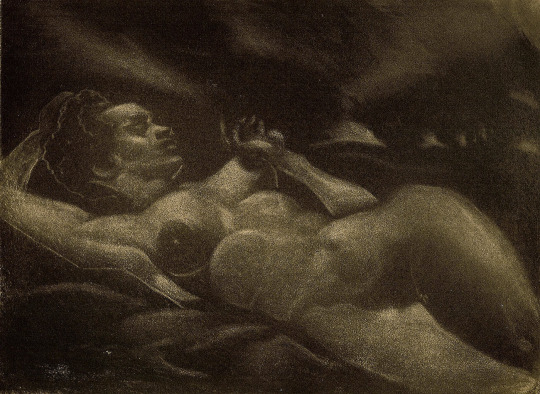
Detail: Dox Thrash, (American, 1893–1965), Siesta, ca. 1944–48, carborundum mezzotint, on loan from Dolan/Maxwell

John Vanderlyn (American, 1776-1852), Ariadne Asleep on the Island of Naxos, 1809–14, oil on canvas, 68½ x 87 in. Pennsylvania Academy of the Fine Arts, 1809–14. © Pennsylvania Academy of the Fine Arts.
A particularly powerful section of the exhibition contains Thrash’s portraits of African Americans. Most are not identified; rather, they have titles such as Woman in Blue (1940s) and Head of a Young Man (1940-50). Yet they are painted with such a powerful sense of character. These are clearly portraits of people Thrash knew personally. Their individualism shines through. Sporting a stylish hat, she is not a mammy; dressed in a tie, he is not a laborer – the two characteristic professions given to African Americans in the overwhelming White, racist media. These are successful, proud, self-confident members of the black urban middle class.

Dox Thrash (American, 1893–1965), Woman in Blue, 1940s, watercolor, private collection
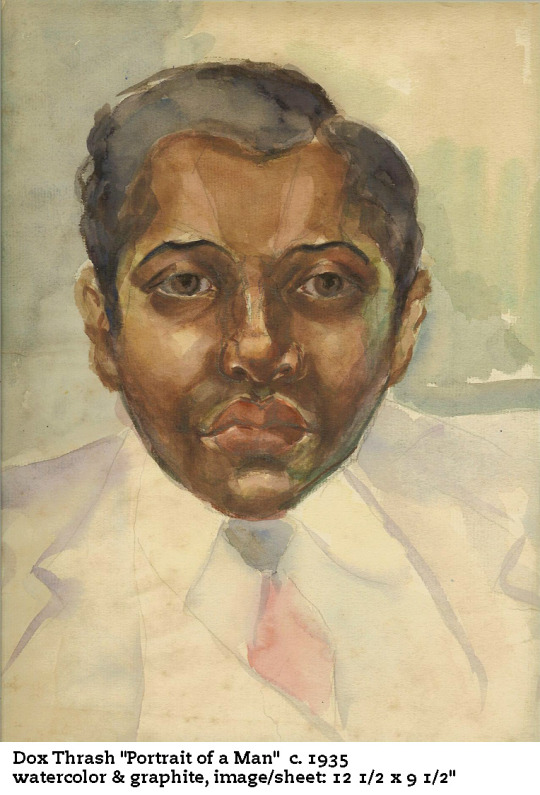
In that they are without specific identities and represent a type, such images by Thrash relate to a well-established genre in European painting, the tronie. Particularly popular in the seventeenth century, the tronie was a type of genre painting in portrait format. It was an artistic exercise in the depiction and capture of human states and emotions, such as old age, anger, and laughter. The emphasis was upon the realistic portrayal of the particular emotion without necessarily conveying a sense of the individual or the model. Leonardo da Vinci (1454-1519) frequently juxtaposed tronies of old age and youth in his sketchbooks.
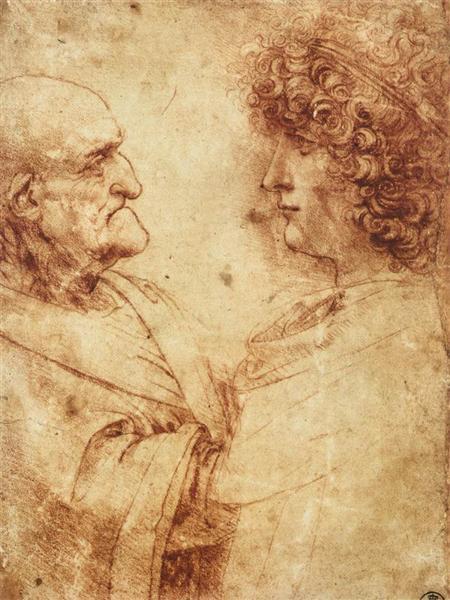
Leonardo da Vinci (Italian, 1452-1519), Heads of an old man and a youth, ca.1495, chalk, paper, Uffizi Gallery. © Gabinetto Fotografico delle Gallerie degli Uffizi
Both Peter Paul Rubens (1577-1640) and Rembrandt Van Rijn (1606-1669) painted tronies. But both also captured something of the character and identity of their live models.
When Rembrandt first settled in Amsterdam in 1632, he lived on Judenbeestraat (Jewish Broad Street) in a house that is now the Rembrandt House Museum. He not only befriended Jewish intellectuals like Samuel Menasseh ben Israel, whose portrait he etched in 1636, but he drew tronies based upon his Jewish neighbors. These he employed in his paintings of Biblical scenes, as Pharisees, high priests, and the like to lend his images an air of historical accuracy.
Among the neighbors who sat for Rembrandt so that he could develop his stock of characters were members of Amsterdam’s small African community. They too lived in the Judenbreestraat district. Although the Netherlands was heavily involved in the slave trade, Dutch law did not recognize slavery on Dutch soil. Scholars associated with the Rembrandt House Museum’s new exhibition have documented the lives of approximately 100 Africans living in Amsterdam. Most of the women worked as servants, many in the households of Sephardic Jews exiled from Spain and Portugal, two European countries that recognized the state of slavery on their soil. Many of the men were Brazilian sailors, who presumably jumped ship when they arrived in port to claim their freedom.
The exhibition contains seven Rembrandt images and forty-nine works by his contemporaries. The works are noteworthy for their lack of racist caricature and stereotyping. Many of the characters are represented with sympathy and compassion. They are ennobled by everyday jobs rather than disempowered, as so often in eighteenth-century portraiture, by appearing as servants.
In our collection, we have a superb painting that epitomizes this moment in seventeenth-century Europe when Africans were seen and recorded with sympathy and compassion, as individual human beings before the onset of racial stereotyping. The painting is my personal favorite in the collection, Rubens’ stunning Head of a Moor (ca.1618).
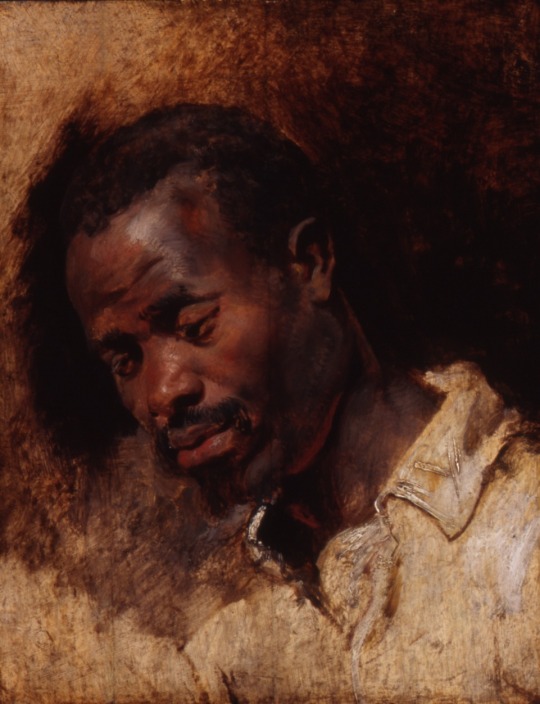
Peter Paul Rubens, (Flemish, 1577-1640), Head of a Moor, ca. 1620, oil on panel, 29 3/4 × 26 1/2 in. The Hyde Collection, Glens Falls, NY, Gift of Charlotte Pruyn Hyde, 1971.40.
Like any other tronie, this is an artistic exercise for Rubens. He is trying to solve the question, as a master colorist: How do I convincing render the face of an African man? It will not do for him to simply warm up a brown, add some white for highlights and black for shadows, as European artists had done in generations past. Compare Ruben’s head with the African magus in The Hyde’s Adoration of the Magi by an Antwerp Mannerist, ca. 1520. Rubens uses a stroke of red to define the underside of his African sitter’s chin. Red warms his skin tones in lighted areas. The shadows on the side of his face are made up of strokes of blue-grey and deep blue and black.

Antwerp Mannerist, after Jan de Beer (Flemish, ca.1475 - ca.1528), Adoration of the Magi, ca. 1520, oil on oak panel, 29 x 25 1/4 in. The Hyde Collection, Glens Falls, NY, Bequest of Charlotte Pruyn Hyde, 1971.2.
Rubens knew this man and this was not the first time that he had painted him. The Royal Museums of Fine Arts, Belgium has an oil study in which Rubens examines the same man from four different angles.
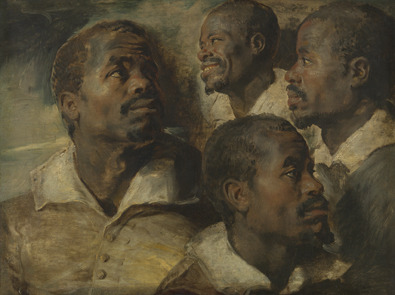
Peter Paul Rubens (Flemish, 1577-1640), Four Studies for the Head of a Moor, 1613-15, oil on canvas, 51 x 66 cm. The Royal Museum of Fine Arts Belgium, inv. 3716. Musées royaux des Beaux-Arts de Belgique, Bruxelles / photo : J. Geleyns.
That Rubens brought a black man in his studio to sit for him was such a significant event that others in the studio made their own studies. One, by an unknown hand, now hangs at the J. Paul Getty Museum. Anthony Van Dyck, who worked briefly in Rubens’ studio, included a profile drawing of this man smiling on the lower right of a sheet of eleven pen and ink head studies now in the Chatsworth Collection in Britain.
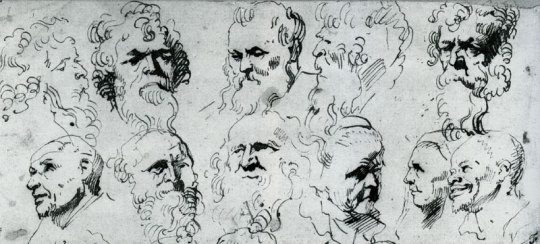
Anthony Van Dyck (Flemish, 1599-1641), Records of Eleven Head Studies, 1618-20, pen and ink, Devonshire Collection, Chatsworth.
Who the man was and how Rubens came to know him and to invite him to his studio at least twice over the course of a few years is not known. In the first half the seventeenth century, Antwerp was Europe’s leading port. Portuguese and Spanish merchants sent their ships directly there from their African and New World colonies. The man may have been a servant or have arrived as a sailor off one of those vessels.
This unknown African was not even the first Rubens painted. While in Rome in 1609, Rubens executed an oil study of an African man wearing a turban. The work is now at the Getty Museum. Shortly thereafter, he used the head to make a free copy of a famous portrait by Jan Cornelisz. Vermeyen (1500-1559) of a Tunisian king, Mulay Ahmad. Rubens’ version survives at the Museum of Fine Arts, Boston, though Vermeyen’s is lost.

Peter Paul Rubens (Flemish, 1577-1640), The Head of an African Man Wearing a Turban, 1609–11, oil on paper laid down on panel, 21 1/4 × 15 1/2 in. The J. Paul Getty Museum, 2018.48. Digital image courtesy of the Getty's Open Content Program.
Rubens employed the image of this turbaned African as the model for the Black King in several altarpieces depicting the Adoration of the Magi. A popular subject for altarpieces at the time, the Adoration of the Magi afforded artists one of their few opportunities to paint non-Europeans. In the later Middle Ages, the three kings had come to represent the three known continents. In Counter-Reformation theology, black Africans represented the Gentiles; those around the world willing to receive the Word and become Christians.

Peter Paul Rubens (Flemish, 1577-1640), The Adoration of the Magi, 1609, 1628-29 oil on canvas, 355.5 x 493 cm. The Prado Museum. © The Prado Museum.
Africansalso appeared as attendants in mythological and historical paintings. Rubens used two of the heads from the Brussels oil study in classical paintings: The Drunken Silenus, (1618-25) at the Alte Pinakothek in Munich and Nature Adorned by the Three Graces (ca. 1615) at the Kelvingrove Art Gallery and Museum, Glasgow. No surviving work has been found that specifically uses the head from The Hyde’s study.

Peter Paul Rubens (Flemish, 1577-1640), The Drunken Silenus, 1618–1625, oil on canvas, 212 x 214 cm. The Alte Pinakothek, Munich, 319. © Bayerische Staatsgemäldesammlungen.
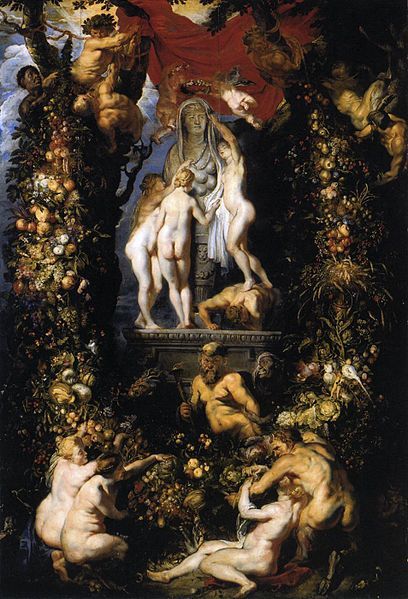
Peter Paul Rubens (Flemish, 1577-1640) and Jan Brueghel the Elder (Flemish 1568-1625), Nature Adorned by the Three Graces, ca. 1618, oil on panel, 42 x 28.5 in., Kelvingrove Art Gallery and Museum, Glasgow. Commons.wikimedia.com.
At The Hyde, we will explore the works by African American artists again in the winter of 2021 with the exhibition THE HARMON & HARRIET KELLEY COLLECTION OF AFRICAN AMERICAN ART: WORKS ON PAPER. Dox Thrash will make a return along with other artists who sought to insert the black experience into the European art traditions in which they had been schooled. There will be others, like Horace Pipin and Jacob Lawrence, who used African rather than European models to create a discernibly black art. In the following winter, we will present ROBERT BLACKBURN & AMERICAN PRINTMAKING. This exhibition will highlight the work of this under-represented abstract printmaker, while also placing him in the context of his contemporaries, many of whom were white and are, thus, better known.
The Hyde’s Rubens and Eakins paintings discussed here are on permanent display in Hyde House. In addition, we frequently put on view in the Education Wing Sam Gilliam’s Asking. I hope it will not be too much longer before we can welcome you back to The Hyde and you can explore our works discussed here, in person.

Sam Gilliam, (American, born 1933), Asking, 1972, Acrylic on canvas, 82 x 76 1/4 in. The Hyde Collection, Glens Falls, NY, Gift of Dr. Robert and Jane Lewit, 2010.17. ©1972 Sam Gilliam
#hydecollection#doxthrash#rembrandt#goya#rubens#museum of fine arts boston#j paul getty museum#sam gilliam
2 notes
·
View notes
Text
Artistry
Request: #118 for anon(?) with Bang Yongguk
A/N: I can’t find who requested this, but I’m sorry for the wait! I had a lot of fun with this idea, so much that it’s not a drabble at all, oops.
Word count: 1410

“Make a portrait of me.”
It was the sentence you heard the most from your friend. Yongguk was incessant ever since he found out you were taking an art class over the summer break. You hadn’t expected him to be so invested in getting you to draw him. It wasn’t like drawing was something new; you had been a budding artist for years now. But with your increased interest in improving your artistry came his own avid attention in making sure by the end of summer you had sketched him.
At first, you declined, claiming your focus was on landscapes and sceneries. And then you were genuinely busy attempting to get your projects done and hold down your part time job too. But when he came over to your house as you worked on a sketch for class tomorrow, Yongguk had seen your latest creation and let out a disgruntled sigh.
“You said you weren’t drawing portraits this summer!”
“Technically, it’s a specific kind of portrait,” you mentioned with a slight blush rising on your cheeks as you shaded in well, some other type of cheeks.
“You did this with a nude model, right?” he asked indignantly, his deep voice crackling. “I’m hurt!”
“You’re acting so unlike yourself.” Closing the sketchbook so you could escape his scrutiny of your subject for this week, you turned and looked at him. Yongguk’s eyes were wider than usual, but they otherwise avoided your gaze. He’d been like that all summer too. It was confusing to see the usually calm exterior of your friend less settled. “Why is it so important I draw you?”
“I just want to see how I’d look on paper by your hand,” he admitted, looking over your shoulder at your calendar. His gaze remained there as you smiled.
“That’s sweet, but I honestly don’t think I could draw you.”
He finally looked back at you. “Why not?”
“Because no matter how much I’d try, you’d still turn out ugly.”
“Y/N!” he cried as you began giggling, his hands now attacking you to give you a real reason to laugh.

Later that evening you realised you did want to draw Yongguk, but it couldn’t be in a formal arrangement. You knew you’d have to capture him when he wasn’t watching to garner his true personality. And so you messaged him since he had left an hour ago, asking if he was busy. Of course, being the musician and workaholic that he was, the answer took some time to reach you.
At studio, bring food if you’re coming.
With a bag of snacks in one hand and your sketchbook under the other arm, you knocked on the door to his studio, the taller man coming to let you in a moment later. His eyes lit up at the food you handed him. “Lonely?”
“I figured both of us could work on our art together,” you suggested and he smiled, gesturing for you to take a seat on his sofa, whilst he went back to his desk. At first, you were anxious, playing around with the nude sketch in case he looked your way. But you knew better, once Yongguk was in his element, it would be hard to attract his attention elsewhere. He had his headphones on as well, so you knew now you had your chance to start drawing.
You worked on the base outline for a while, deepening your details in some areas more than others. Hours passed, Yongguk unaware that your eyes were soaking in his side profile as he worked. Whilst he played with buttons you had no idea did what, your own tool in your hand sculpted him out on paper. You were so invested in finishing the piece that you fought off exhaustion, avidly comparing the man in front of you to the one by your hand. You had been right, it didn’t matter how many precise strokes you did, you couldn’t exactly capture all of him.
But unlike your teasing words earlier, it was because he was far too handsome. His eyes were complex to get the right emotions within, and his strong nose and jawline just didn’t seem as beautiful on paper. His lips were troubling you the most, because the longer you stared at them, the harder it was for you to contain some of your inner thoughts.
You wanted to kiss those lips. Even on paper, you were stunned by how beautiful they were.
You were still in your own world of drawing Yongguk that you didn’t notice he had moved until you felt the sofa dip beside you suddenly. It made you jump in fright, and Yongguk reached out to catch the sketchbook you dropped in the process. It all seemed to happen in slow motion, you attempted to get it before he did, and when that failed you tried to hide the page you were working on. But his hand was too strong and you stared at that hand dumbly, wondering if you had captured all its warmth and masculinity with your pencil.
“You weren’t working on the nude?” he asked, even though it was pretty obvious as he stared back at his portrait that you had swapped subjects. There was a hint of his gummy smile, but he suppressed it as much as he could. “You’re right, I am ugly.”
“Hardly, you’re too beautiful!” you blurted out and then covered your mouth with your hand, averting your eyes to the equipment on his desk.
Yongguk’s deep chuckle hit your ears then and you glowered at the keyboard still, wishing you hadn’t slipped up. You wondered if you’d be able to excuse it down to being exhausted.
“I’m keeping this, sign it.”
You turned back to your friend as he put the book back in your lap and pointed at the paper. You shook your head. “It’s not finished.”
“It looks it to me.”
“I still have a lot more to do,” you mumbled and Yongguk peered at you for a moment before he got up.
“Alright then, since I’m not finished either, should I share what I have been working on?” he offered and you nodded eagerly, feeling your previous embarrassment subside at the chance to hear his music. It was always soul reaching and you were already anticipating the rush of feelings.
Yongguk watched you intently as the song started up, and for a moment you were just entranced with the husky tone of his rap. But then you started listening to the lyrics, your eyes widening the longer the love confession went on. Your throat dried up and all the moisture moved to your eyes, a tear easily slipping down your face at what you were experiencing. You weren’t sure that the song had finished even when the room fell silent, mostly because your brain was repeating the lyrics over and over.
“I was going to gift you this when you finally drew me,” he said softly, and you looked over at Yongguk through your blurred vision. “I like you, Y/N.”
“So that’s why you wanted me to draw you?”
You could see his blush even through your tears. “I hoped if you stared at me long enough, you might like what you see.”
“You fool; I’ve liked you for years.”
“Really?” he asked, moving back over to your side, and it was then that you noticed your sketchbook was still open.
You gasped; your tears had wet the image of him. “What am I going to do?!”
“It’s perfect how it is; you’re perfect how you are.”
You smiled, despite your emotions still getting the better of you and he finally let you in his arms, your body burying in deeper. You felt instant comfort from his embrace and sighed in content. Shifting back a little, you looked up into the face you had been staring at all night long and smiled.
“I guess I could just keep drawing more of you.”
“Even a nude?” he asked cheekily and you gasped, slapping his arm as he laughed loudly. He pulled you back into his arms and held you tightly. “It’s a good thing we’re both artists. For every picture you give me, I’ll have a song inspired by you.”
“Then you’ll be singing to me for the rest of your life?” you wondered and Yongguk gently kissed your lips for the first time before responding.
“I hope you’re prepared to make me your favourite model.”
_________________
All rights reserved © prettywordsyouleft
[Drabble Game Masterlist] | [B.A.P Masterlist] | [Main Masterlist] | [Request Guidelines]
#bang yongguk#yongguk#b.a.p#b.a.p imagines#b.a.p scenarios#b.a.p fiction#b.a.p fluff#yongguk imagines#yongguk scenarios#yongguk fiction#yongguk fluff#youxidol drabble game#prettywordsyouleft requested
148 notes
·
View notes
Text
sing to me muse, of the history of muses

I idly clicked on a link to this WIRED piece about Lena, the woman behind the first JPEG image, and got completely sucked in. I had no idea that the original image used to create the JPEG compression was a Playboy centerfold (!) and the article not only goes and finds the original Lena but dives into the history of women and muses in art, which is extremely my jam.
It draws a through line from L’inconnu de la Seine (whose face would be later used on CPR dummies) to Audrey Munson (muse of early 20th century urban sculpture), to Kodak’s Shirleys (women photographed to calibrate film), to Lena herself. A fascinating read.

I ended up diving even deeper into the story of Audrey Munson, and it’s a helluva ride. This piece gives an incredible overview of her life (28 min read)—from model of almost 100 documented statues, include at the Panama-Pacific Exhibition (see above, she’s the statue that adorns the roof) to the first woman to be nude in a motion picture—which contains sweeping ups and downs, and constant attempts at reinvention. It’s ultimately a heartbreaking one, but I’m glad more light is being shed on her life:
When she smiled, her eyes were heavy-lidded and she had a toothy overbite. But when she posed, she had a face that could launch a thousand ships: a chin that curved like the wood on a violin, cheekbones that caught the light and revealed the perfect symmetry of a human face.
I am in particular, struck by the fact that I had never thought about these statues, particularly the allegorical ones, as being based on models. (Did I think they were somehow just that good at sculpture? Unclear). It now seems so intimate—almost uncomfortably so—to look at these statues, knowing much more about the woman they’re based on.

This goes hand-in-hand with a lot of conversations that have been going on about Greek statuary recently. It’s now at least somewhat well-known that Greek statues were originally brightly colored, and this piece in the New Yorker is a great overview of that, though there’s now been some pushback at the bright colors themselves—there are no variants in hues in these restorations, no subtleties, when other Greco-Roman art (mosaics, frescoes—see above), or adjacent (Fayum portraits) have both of those. They also choose this awful color pink for skin which is just… not based in what we know the Greeks looked like!

Two final things to close out our talk of muses: they have discovered the identity of L’Origine du monde (NSFW!)—it’s ballet dancer Constance Queniaux; and two: I just found out about these Sleeping Beauty automata that are designed to breathe slowly. It is eerily realistic:
vimeo
etcetera: An ode to glass bricks. Someone has catalogued all the fossils that exist in monuments in Washington. D.C. Oh, well when you put it that way:

9 notes
·
View notes
Photo

Much Too Shy (1942) review -- George Formby’s Columbia films are generally considered inferior to those he made for ATP. There are a number of possible reasons for this, although arguments can be made for/against all of these statements:
a. the formula, character, and attributes of the films were getting stale. [It’s been stated that Formby moved to Columbia with the intention of exploring different avenues.] Critics even claimed that Formby’s songs were less novel and interesting and his best “material” had already been used.
b. Columbia didn’t give the films the same level of production that the ATP films had enjoyed.
c. times had changed and while Formby remained personally popular, his new films simply didn’t have the same appeal as their predecessors.
At least some evidence of each of these can be found in South American George, Much Too Shy, and Get Cracking, his first three Columbia productions. Much Too Shy, rather surprisingly (at least 84% of 1942 British feature films have some war-related content), is a contemporary picture but there is no mention of World War II—not even a covert reference such as was included in South American George. No characters are shown in military uniform, and there are no mentions or even oblique indications of wartime shortages or restrictions. This is not necessarily a problem, but the film seems to be working awfully hard to ignore the war at all costs, lending it an air of unreality.
Like Get Cracking, Much Too Shy places George in a village milieu, as a small-business owner who’s at least moderately competent and well-liked. In both films he has a juvenile sidekick--in Much Too Shy it’s a younger brother—and is involved in the romantic pursuit of a local young woman, in competition with another suitor.
One of the major problems with Much Too Shy is that the film’s plot hangs on an extremely flimsy premise---actually an interlocking series of illogical premises. George is the village handyman of “Standstilton Green,” and one of his regular chores is drawing posters for the local cinema (we see one for Dead End, and another for a fictional Mae West picture). He also does portraits and seems to be reasonably talented. But he has one (very unlikely) weakness: he can only draw faces (and inanimate objects), not human bodies. George claims he was too shy to draw live models and consequently dropped out of art lessons without ever learning how. However, his portraits are admittedly all based on photographs, and so the audience is supposed to believe he can accurately copy a face from a photo, but is incapable of doing the same thing with a photo of a human body?
This leads to the film’s main plot contrivance. George, hoping to improve his technique, visits an art school in London: the students mock his interest in representational art, preferring avant-garde interpretations. George draws 3 faces (taken from a local newspaper photo) on a large canvas, then leaves. He returns a very short time later to retrieve his coat, and the students present him with “his” painting: they’ve added nude bodies (with the naughty bits discreetly covered, of course) to the 3 faces (and in fact have converted his sketches of the faces to painted images as well). Through another illogical chain of events, a sidewalk artist sells the painting to an ad agency, which rapidly converts it to a soap campaign, complete with billboards and large newspaper ads.
The image shocks the residents of George’s village—especially the 3 women whose faces are represented—and no one can imagine who might have painted it. No one even thinks of George, who is a. known to be an artist, b. who signs his work with his initials, which c. clearly appear on the advertisement artwork.
The script thus compels the viewer to ignore this blatantly ridiculous chain of events, which far exceeds the usual “willing suspension of disbelief” cinema audiences are expected to possess.
After spending a large portion of the running time setting up this situation, the film rushes towards the conclusion. In a rather harrowing scene that concludes with a long slapstick sequence (similar to one in Get Cracking), an irate group of village women attack George’s house trailer and gleefully set it on fire! This is not really played for comedy: the women viciously threaten George and when he (and his little brother) refuse to emerge from the trailer, they decide to burn his home. The trailer becomes unmoored and rolls wildly down various country lanes before finally crashing.
The film concludes with a long-ish trial sequence in which George is sued for damaging the reputations of his 3 inadvertent models (the plaintiff’s attorney happens to be his village rival for the hand of Jackie Somers): Jackie, postmistress Amelia, and Lady Driscoll. Jackie has no grudge against George, and with Jimmy’s assistance, coaches George in his defence. Spinster Amelia used the “fame” she accrued from the nude portrait to snag storekeeper Harfield, who was previously quite resistent to her “charms.” Lady Driscoll is exposed as a former fan dancer, and her objection that the painting depicted her with a large bust is disproven by her old publicity. Consequently, George is cleared of defamation charges.
Much Too Shy has a decent cast, although it’s slightly top-heavy, with George, Jimmy Clitheroe (Jimmy), Eileen Bennett (Jackie), Hilda Bayley (Lady Driscoll), and Kathleen Harrison (Amelia) getting most of the attention. The minor roles include a number of familiar faces, including Charles Hawtrey, Wally Patch, and Valentine Dyall. While Much Too Shy doesn’t look cheap, it is very limited in its settings, was shot mostly in the studio, and features generally forgettable songs (most of them sans ukelele).
1 note
·
View note
Link
This November, the Whitney Museum of American Art offers a major reassessment with “Andy Warhol—From A to B and Back Again,” the first American retrospective of the artist in nearly 30 years. Featuring more than 350 works of art, ranging from paintings Warhol did in his childhood living room in Pittsburgh to his notorious films of the 1960s to his late-career collaborations with Jean-Michel Basquiat and Keith Haring, the exhibition will later travel to the San Francisco Museum of Modern Art and the Art Institute of Chicago.
One of its most groundbreaking aspects will be the concentration on the least-known time of Warhol’s life, the 1950s. During his first decade in New York, he was a young commercial artist and an openly gay man, trying to turn himself into a fine artist. The Whitney show brings together about 70 Warhol works from that period: elegant drawings of shoes for advertising campaigns, ballpoint pen drawings of men in drag, fey illustrated books that he printed privately for friends, male nudes in gold leaf, a sketchbook of men’s torsos. The assumption has been that Warhol’s career as a serious artist began in the summer of 1962, with Irving Blum’s famous exhibition at the Ferus Gallery, in Los Angeles, of 32 soup cans, but the Whitney show allows the earlier paintings, drawings, and commercial work to be seen in a new context. “This early period was critical for Warhol,” says Neil Printz, the editor of the artist’s catalogue raisonné. “It was instrumental and utterly productive.” Blake Gopnik, who has spent years researching a biography of the artist, to be published next fall, believes that past discussions of the period, especially in the context of the hyper-conservative McCarthy era, have been off base. “What truly matters about Warhol’s 1950s drawings is the brazenly gay content they carry,” Gopnik says. “The very banality of their style lets them function as a transparent carrier, you could say, for their queer themes.”
Warhol arrived in New York in the summer of 1949, when he was just 21 years old. On his second day in the city, he approached Tina Fredericks, the well-known art director of Glamour magazine, who told him that she was looking for drawings of shoes and that she needed them the next morning. She hired Warhol on the spot; his first illustrations appeared in the magazine’s September issue, depicting five red pumps ascending the ladder of success. His rise as a commercial artist was meteoric. He regularly illustrated articles for Glamour, Seventeen, and Mademoiselle, and drew album covers for Columbia records. By 1955, he was the sole illustrator for the prestigious ads for I. Miller & Sons shoes, which appeared on the society pages of The New York Times. By the mid-’50s, particularly in the New York fashion world, Warhol had arrived. As a New Year’s gift in 1957, he sent Diana Vreeland, who was at the time the fashion editor of Harper’s Bazaar, a small book of 18 delicately colored lithographs, 25 Cats Named Sam and One Blue Pussy. “How much I appreciate the book I have on my desk of the delicious cats,” Vreeland wrote Warhol. “Your drawings are so charming.”
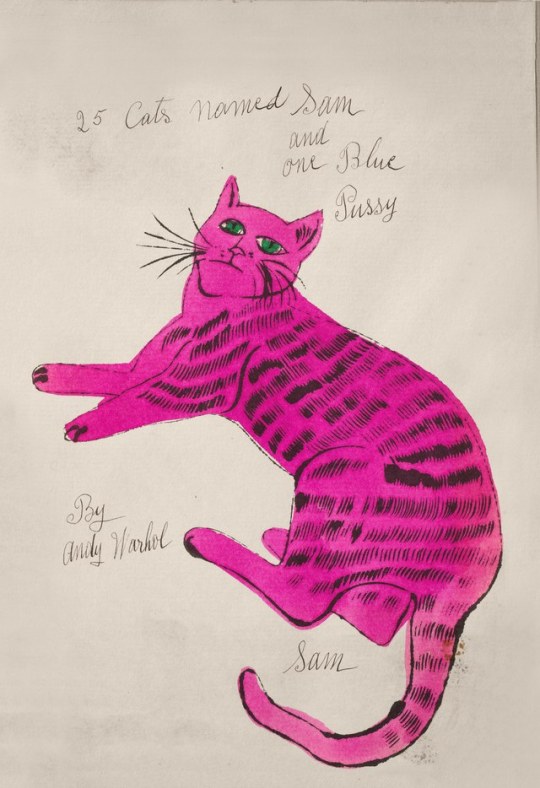
At the same time that he was making elegant, whimsical drawings of smiling perfume bottles for magazines, Warhol was exploring more personal work, such as sexy portraits of tattooed sailors and fanciful drawings of gold slippers that he named after such iconic figures as Mae West and Zsa Zsa Gabor. But his first attempts to move into the realm of fine art were not successful. In the mid-1950s, Warhol was commissioned for the first time by the department store Bonwit Teller to create displays for its windows on Fifth Avenue. His installation appeared next to that of Robert Rauschenberg and Jasper Johns, artists just as unknown as Warhol, who worked together under the pseudonym of Matson Jones. Hoping that the visibility would lead to important gallery exhibitions, Warhol used a photograph of a man in drag posed as a fashion model. Even other gay artists were horrified. As Warhol later recalled, “Bob and Jasper came and looked at what I was doing and laughed at me. They pointed their fingers and laughed—they were so mean.” As De Salvo, who met Warhol in the mid-’80s and has become one of the leading experts on his early work, characterizes the incident: “Andy was too swish and chichi for Bob and Jasper.”
Considering that homosexuality was against the law in the U.S. in the 1950s, and certainly not accepted in the New York art world, Warhol was remarkably open about being gay (an essay in the Whitney catalog about those years is cheekily titled, “Picture Portraits: Miss Warhol Knows What the Client Wants”). “Being gay was absolutely vital to who Warhol was in 1950s New York, to how he was seen—both for better and worse—and to the art he made,” Gopnik points out. “All his attempts at making serious art in that era involved imagery that still reads as gay to us and screamed it in the 1950s. That made his art highly appreciated in the gay world around Warhol and almost intolerable, and mostly incomprehensible, to mainstream straights.” The subjects of Warhol’s drawings were often men in drag. He did not hesitate to depict two men kissing or, it is said, to ask nearly any man he met if he could draw his cock. His first exhibition of art, in 1952 for the openly gay Alexander Iolas at the Hugo Gallery, in New York, was called “Fifteen Drawings Based on the Writings of Truman Capote.” “An air of carefully studied perversity,” a leading art critic deemed it.
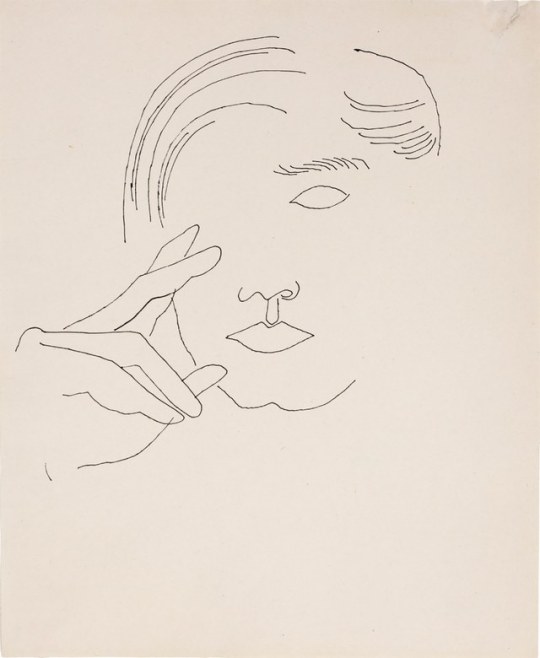
Although there is overt homoeroticism in much of Warhol’s personal art in the ’50s, later in the decade it is often disguised. “It is the beginning of seeing how Warhol, as the years go on, and his style emerges into the Pop art that we know, has this layered language,” De Salvo explains. “Marilyn Monroe can be read multiple ways. Elvis Presley can be read multiple ways. And the early Popeye, Superman, and Dick Tracy paintings—it is interesting that he focuses on these archetypes, all of these straight, powerful guys. Everything has multiple meanings, and this notion of his sexuality—of gay sexuality—continues to be coded, obscured, but it’s there, depending on who is reading it.”
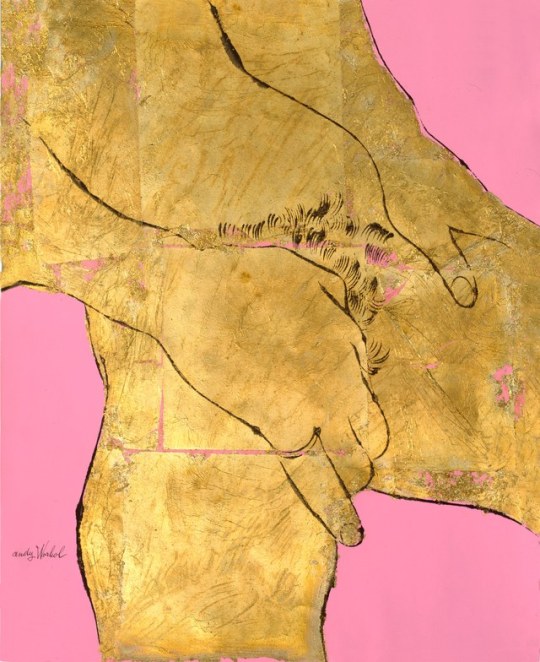
Male Nude, circa 1957, is typical of a time when Warhol would routinely ask men if he could draw their private parts.
© The Andy Warhol Foundation for the Visual Arts, Inc./Artists Rights Society (ARS) New York.
With the Warhol show taking over nearly three floors at the Whitney, making it the largest devoted to a single artist in the new downtown building, which opened in 2015, De Salvo believes that this more complete picture will deepen the understanding of his development into one of the most important postwar artists, particularly for those yet to be convinced of Warhol’s seriousness as an artist. It’s a big Warhol moment: In addition to the Whitney show, the Dia Art Foundation will present Warhol’s Shadows, 1978–1979, a monumental painting in multiple parts, at the Calvin Kleinheadquarters in New York, through December 15. “There are the naysayers who really hate Warhol, who saw him as someone who introduced a crass commercialism, who blurred the line between art and commerce,” De Salvo says. “I think he was making an honest statement about the nature of the United States, which is now true in a way it could not have been imagined in the 1960s. I can’t convince the people who do not want to be convinced, and that’s fine. He’s a provocative figure—he provoked.”
3 notes
·
View notes